DESIGN • BUILD • MAINTAIN

Let’s Hear It From: RYC Going pesticide-free on campus Horticulture Heritage Monrovia stays true to its roots
Pavers Why natural-stone pavers might be right for you ABSOLUTE
































Let’s Hear It From: RYC Going pesticide-free on campus Horticulture Heritage Monrovia stays true to its roots
Pavers Why natural-stone pavers might be right for you ABSOLUTE






























08 11 17 23 29 34 37 40 42 44 47 50
Horticulture Heritage
Based on a legacy of innovation, Monrovia stays true to its roots
Let’s Hear it From: Re:wild Your Campus
Students and groundskeepers work together toward a pesticide-free future
Multi-season Sanctuary
Absolute Landscape & Turf Services delivers a backyard retreat to be enjoyed all-year round
Vibrant in Vietnam
LJ-Group brings a green oasis to the center of Ho Chi Minh City
A Garden in the Rockies
Bowles & Wyer work with industrious clients to blend home and landscape
Perfect Pavers
Bruce Read shares why natural stone pavers are cheaper, more sustainable, and better looking than concrete
Top Tips
Joe Raboine shares his essential recommendations for paver installation
Product Round-Up
Our favorite finds for all things paving
Bidding Wars
The technology vying for the chance to save landscapers time and money
Why Landscapers Need the H2B Visa—and How to Make It Work
Nataly Mualem shares tips for navigating the H-2B Visa
Bringing the Indoors Out
Nine ways to build outdoor spaces that reflect the interior in look and function
Little Interviews
Quick-fire questions to gain a small insight into the people who make up our industry
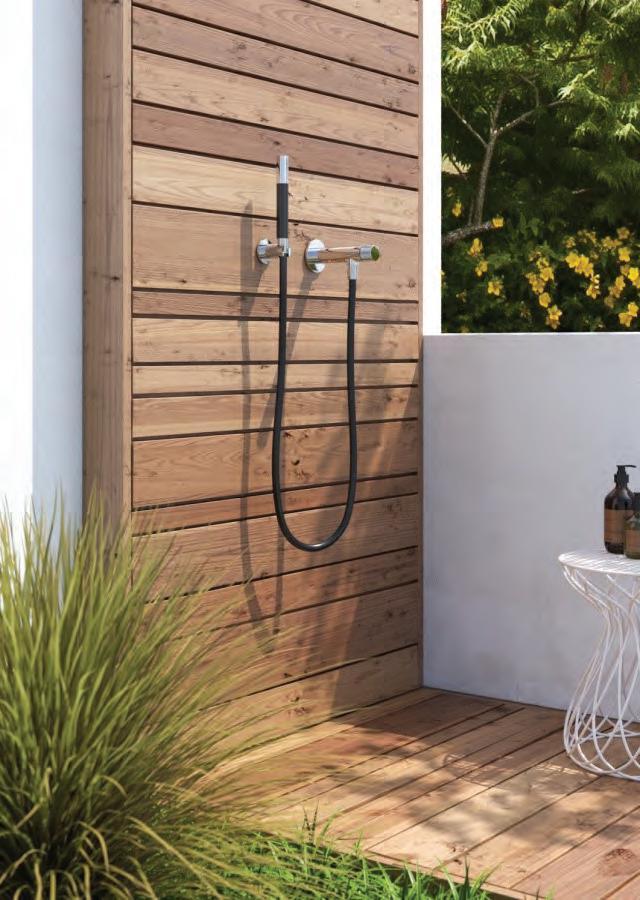
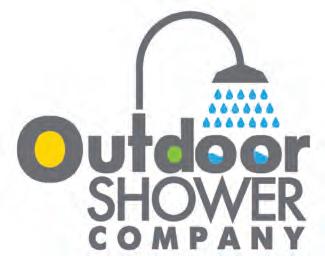



CONTACT
Eljays44 Ltd, Village Workspaces, 11845 W Olympic Blvd, Los Angeles, CA, 90064
EDITORIAL
Deputy editor - Celia Cummiskey celia.cummiskey@eljays44.com (617) 935-2785
Senior subeditor - Katrina Roy katrina.roy@eljays44.com
Senior designer - Kirsty Turek kirsty.turek@eljays44.com
ADVERTISING
Sales executive - Ollie Finch ollie.finch@eljays44.com
+44 (0) 1903 777579
Event director - Tom Glasby tom.glasby@eljays44.com
+44 (0) 1903 9595391
MANAGEMENT
Managing director - Jamie Wilkinson jamie.wilkinson@eljays44.com
+44 (0) 1903 777570
Content director - Nina Mason nina.mason@eljays44.com
+44 (0) 1903 959393
Commercial director - Luke Chaplin luke.chaplin@eljays44.com
+44 (0) 1903 777580
CIRCULATION
Subscription enquiries - Ollie Finch ollie.finch@eljays44.com
+44 (0) 1903 777579
Printed by Southwest Offset Printing
Published by Eljays44 Ltd – Connecting Horticulture. Pro Landscaper’s content is available for licensing overseas. Contact jamie.wilkinson@eljays44.com
Pro Landscaper USA is published 12 times per year by Eljays44 Ltd. The 2025 subscription price is $160. Sub scription records are maintained at Eljays44 Ltd, Village Workspaces, 11845 W Olympic Blvd, Los Angeles, CA, 90064. Articles and information contained in this publication are the copyright of Eljays44 Ltd and may not be reproduced in any form without the written permission of the publishers. The publishers cannot accept responsibility for loss of, or damage to, uncommissioned photographs or manuscripts.
Whilst every effort has been made to maintain the integrity of our advertisers, we accept no responsibility for any problem, complaints, or subsequent litigation arising from readers’ responses to advertisements in the magazine. We also wish to emphasize that views expressed by editorial contributors are not necessarily those of the publishers. Reproduction of any part of this magazine is strictly forbidden.
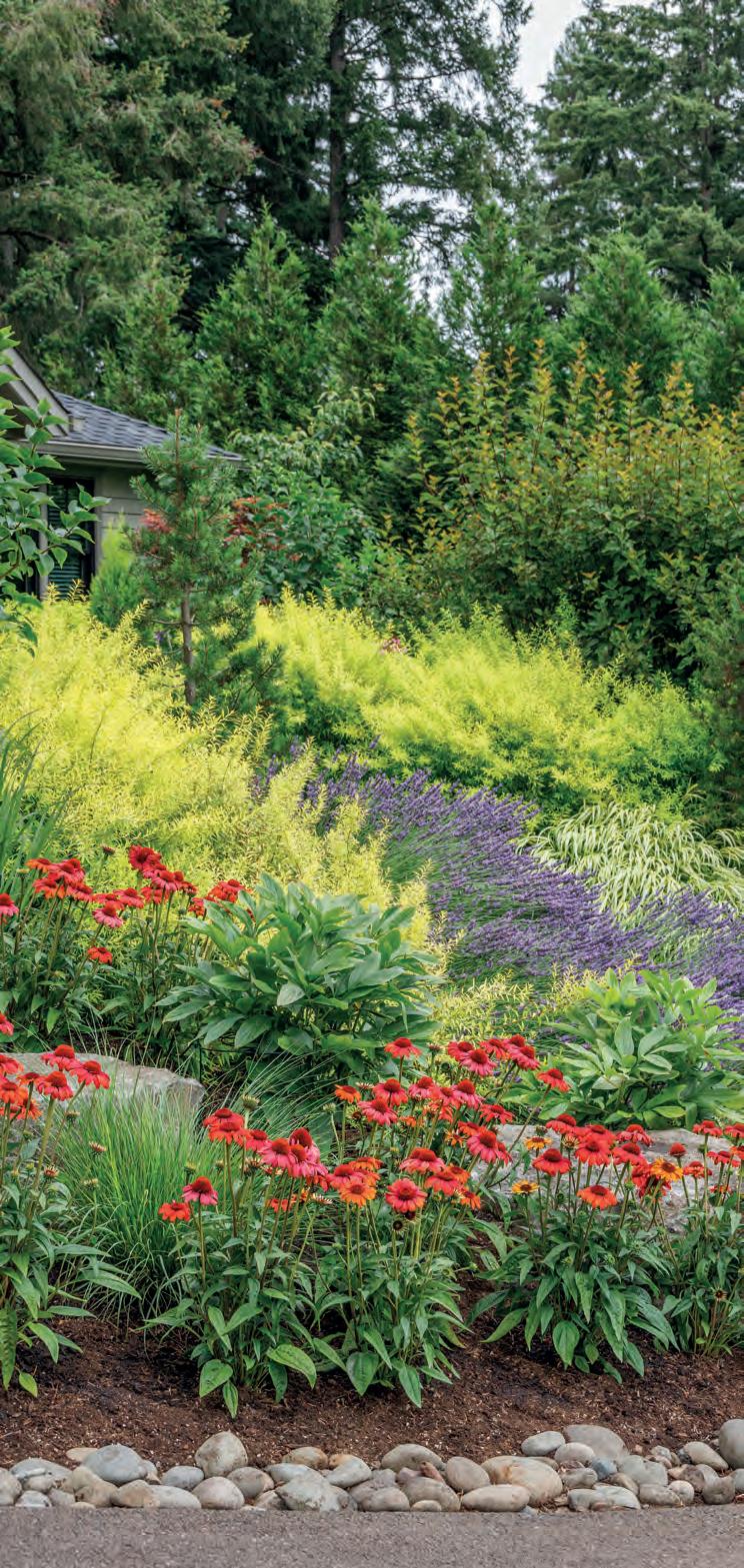
Time sure flies when you’re having fun! Our May issue marks the third installment of Pro Landscaper USA. Each issue has offered us the amazing opportunity to cover the developing stories unfolding in our industry, feature the work of talented and creative designers, and preview exciting new products; and with every issue, the Pro Landscaper USA team also learns more from our readers about the important topics and new stories that matter most to them.

This April, we had the chance to meet with industry professionals in San Diego at the California Landscape Contractors Association’s happy hour event. It is at events like these where we’re able to connect with our readership and hear their feedback, that drive us to continue to work hard to make every issue better than the last.
In our May issue, readers will find our feature interview with Re:wild Your Campus, an organization that is helping grounds maintenance teams and students work together towards creating biodiverse, pesticide-free college campuses, a stunning international portfolio from LJ-Group, top-tips on paver installation, and so much more.
With every new issue, we want to continue to raise the bar. I’d love to hear from readers on how we can best serve the landscaping industry. Please don’t hesitate to reach out to me at celia.cummiskey@eljays44.com. I can’t wait to hear from you!
Happy reading.
New grant opportunities at NAMLA!
The National Association of Minority Landscape Architects (NAMLA) is launching three exciting new grant and award programs this year.
Through a generous grant from the Mellon Foundation, NAMLA will offer a $5,000 quarterly grant for the next two years. This funding will support landscape architects who are applying landscape design to advance place-based history and cultural heritage.
May is National Water Safety Month!
As outdoor living professionals, you play an important role in creating safe, beautiful environments for families to enjoy year-round. May is National Water Safety Month, a nationwide public awareness campaign coordinated by the Pool & Hot Tub Alliance (PHTA) and supported by the American Red Cross, National Drowning Prevention Alliance, National Recreation
In partnership with the Council of Landscape Architectural Registration Boards (CLARB), NAMLA will also provide $2,140 in LARE exam fee reimbursements to support an aspiring landscape architect on their path to licensure.
Additionally, NAMLA is collaborating with OJB Landscape Architecture to host a landscape architecture video competition, awarding $3,000 to the winning entry.
Beyond funding opportunities, NAMLA is experiencing exciting growth in its
student network. New student chapters have recently been established at the Illinois Institute of Technology, Texas A&M University, and the University of Pennsylvania, reflecting a growing movement of future leaders in the field. nationalamla.org

and Park Association, and World Waterpark Association.
Whether you’re designing a backyard oasis that includes a pool or hot tub—or simply maintaining the landscape around one—you are a frontline advocate for water safety. Drowning remains the leading cause of unintentional death for children ages 1 to 4, so educating your clients on the easy actions they can take to reduce the risk of drowning is key.
PHTA encourages all landscape professionals to join the water safety movement this May by sharing resources, informing clients, and contributing to programs that help save lives.
How you can help:
• Share safety materials: Offer water safety brochures to clients whose landscapes include pools, spas, or hot
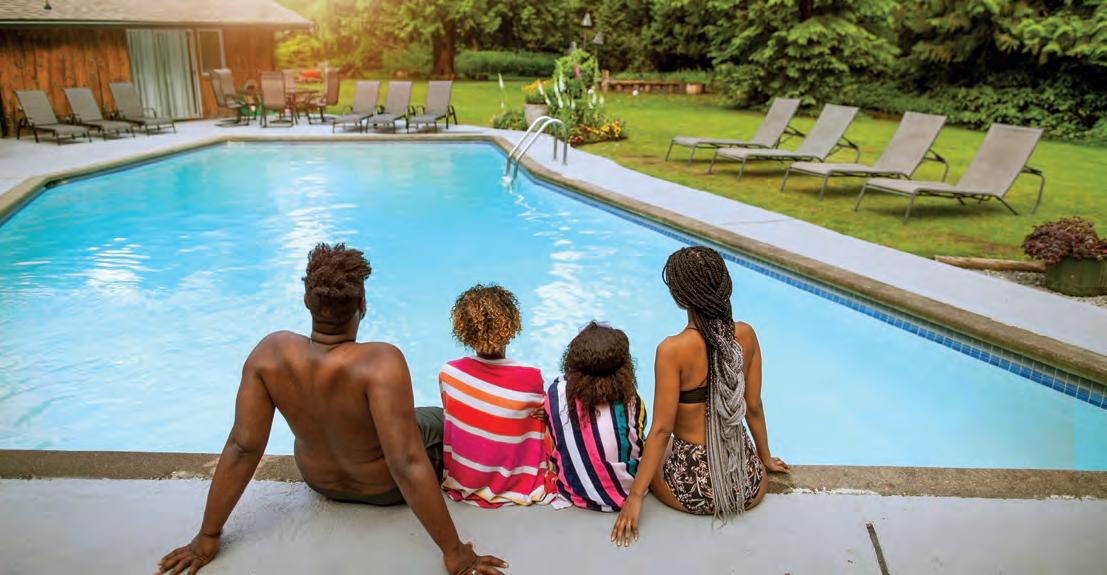
NADRA.ORG, the North American Deck and Railing Association, is a leading organization dedicated to serving the decking industry with a strong focus on promoting safe and sustainable outdoor living spaces.
NADRA plays a vital role in setting industry standards, providing resources for professionals, and fostering relationships within the decking community.
By joining NADRA, members gain access to a wealth of opportunities and support that is tailored to their needs. There are many benefits of NADRA membership, including
educational resources, access to training materials, webinars, and industry insights.
Networking opportunities are available for members to connect with industry experts, suppliers, and like-minded professionals. Industry events and conferences take place throughout the year, so that members can stay up to date on the latest trends. Members also enjoy exclusive discounts on services and events. NADRA.ORG also has certification programs available to enhance members’ skills and credibility.
Advocacy and representation in the codes that govern the decking and railing industry comprises an integral part of NADRA’s work. Members benefit
from NADRA’s advocacy efforts and industry representation.
Joining NADRA is easy. Simply visit the NADRA website, fill out the membership application, and start enjoying the benefits of being a part of the NADRA family.
NADRA is the go-to website for industry professionals and consumers alike. For more info, visit NADRA.ORG
“Doing things for the right reasons and having fun doing them.”
tubs. PHTA offers brochures on topics like Layers of Protection and Pool and Spa Emergency Procedures for Children. phta.org/safetybrochures
• Support learn-to-swim programs: Donate to Step Into Swim, PHTA’s nonprofit drowning prevention initiative
that funds free or low-cost swim lessons for children around the country. stepintoswim.org/donate
• Promote awareness online: Use the National Drowning Prevention Alliance’s free Water Safety Season Toolkit to share ready-made social
media posts, video PSAs, and press releases throughout the month. ndpa.org/toolkit
Together, we can design not just beautiful backyards, but safer ones, too. Learn more at nationalwatersafetymonth.org.


Based on a legacy of innovation, Monrovia stays true to its roots
Almost 100 years ago, Harry Rosedale, an immigrant from Denmark, purchased forty acres in Monrovia, California.
In 1926, most shrubs and trees used in landscaping were planted in the ground and then dug up and repotted when shipped. Rosedale envisioned another way for his newly founded venture, Monrovia Nursery Co.
He began starting his shrubs and trees in containers and keeping them in those same containers for shipping. “Harry believed that not every camellia was the
same, not every lavender was the same, and he sought out to find the best varieties to grow and he believed in patenting them,” says Katie Tamony, chief marketing officer for Monrovia.
“He was one of the first growers in the industry to patent his plants. We now have a legacy of thousands of patented plants— not just from Harry, but continuing today.”
Rosedale was interested in growing hardier, more beautiful plants, and he knew that innovation and experimentation would pave the way forward. In the 1950s, he established an in-house research
department dedicated to developing better soil, making for stronger roots and healthier plants. As a result, Monrovia quickly became known for the consistency and condition of its plants. Soon, it was expanding elsewhere in California, then to Georgia and Oregon as well. Today, Monrovia has built upon Rosedale’s work. It now offers more than 4,000 varieties with 22 million plants sold annually.
“Monrovia is really known for our innovation in the field. We are one of the largest growers to rely on beneficial organisms to reduce pest and disease.
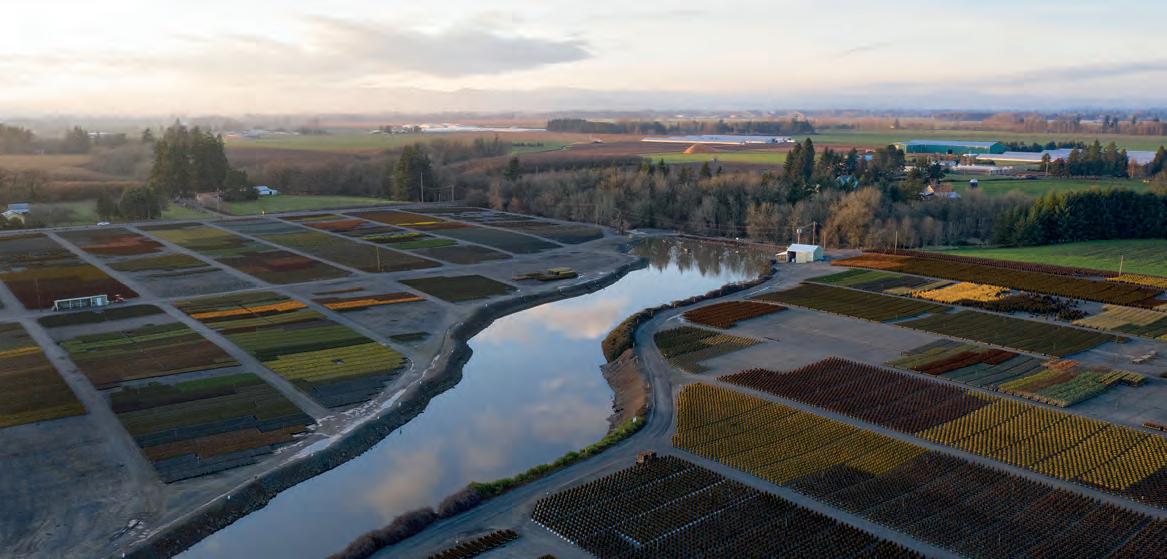



We’ve done a lot of work in water recycling well before anybody else was doing it. We have a groundbreaking system of water recycling, especially for California, where we’ve graded the land, so the water is always draining into these canals. It gets cleaned on our property, moving into a big reservoir, and then it gets recirculated.”
Many of the industry standards now taken for granted—such as cross-country plant shipping, patented plant varieties, and in-house R&D—were pioneered by Rosedale and his team, Tamony says.
“We were one of the first to be able to ship plants across country and do it in a really timely way so that you can order plants this week and get them the next week; and we’re still known for our shipping and logistics work. If you are a customer of Monrovia, we have an online portal for wholesalers, garden centers and landscape professionals that allows for easy plant selection, ordering and shipment tracking. We are still innovating all these years later.”


Monrovia’s commitment to innovation is shared company-wide, regardless of role. “We work with breeders around the world, and I think because we don’t do our own breeding, we’re not tied to any particular plant or way of approaching a new variety. It gives us the freedom to choose the best of the best. Only 5% of what we test actually passes our standard to be considered a true

craftsman noticing ‘Oh, that’s interesting’ and then we see if we can propagate it, if it will grow and flourish. Little Ragu, which is a bay laurel, was a plant that was discovered at our nursery, or Pinkaboo camellia, which is a sport off of Yuletide camellia, that was discovered at our nursery.”
Monrovia has also built a relationship with Dan Hinkley, a plant explorer known for collecting varieties of plants that he then brings to Monrovia to introduce to the North American nursery trade.

improvement. A lot of our plants actually come from our craftsmen spotting an interesting sport at the nursery,” says Tamony. “Some of our greatest plants have come from a sales rep or another nursery
“Hinkley has brought a lot of amazing plants back to us from India and China,” adds Tamony. “We’re one of the few growers that will kind of take a chance on those unusual plants and bring them to market. Monrovia has always been known for doing things that maybe no one else would try to do, and that just continues today.”
Though Monrovia was one of the first nurseries to introduce plant tags for
consumers, they’re now thinking about how to reduce plastic use at the nursery.
“We’re looking at products to make our pots use more post-consumer waste rather than pure plastic. We also limited the size of our tag to reduce our plastic use. We used to use a four-sided booklet tag, but we realized if we cut that down in half and use QR codes and move more of that information online, we can reduce our plastic use in tags by as much as 60%.”
In addition to being on top of industry needs, Monrovia has always focused on the interest of home gardeners, staying wellattuned to the newest trends. “We invest a lot in consumer research, and in our own trend spotting. We survey homeowners, we survey landscape professionals, and we scan the media marketplace to see what’s hot.”
Tamony notes that consumers’ interest in native plants is on the rise, though there may be misconceptions on what exactly they’re asking for.
“What we’re realizing is that a lot of people are confused by the term ‘native.’ They’re maybe looking for the features that natives can offer, like low water use, good for pollinators, drought tolerant. But we stress that it doesn’t have to be an all-or-nothing kind of equation, and that climate-appropriate cultivars and
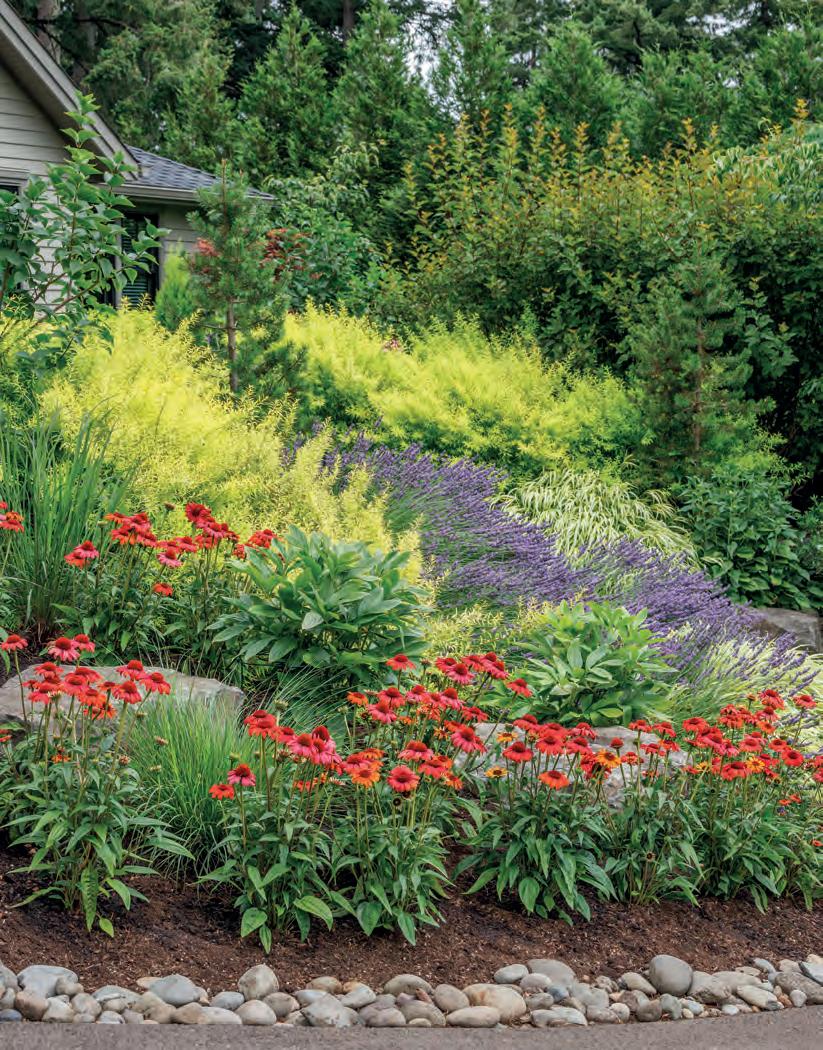
“MONROVIA HAS ALWAYS FOCUSED ON THE INTEREST OF HOME GARDENERS, STAYING WELLATTUNED TO THE NEWEST TRENDS”
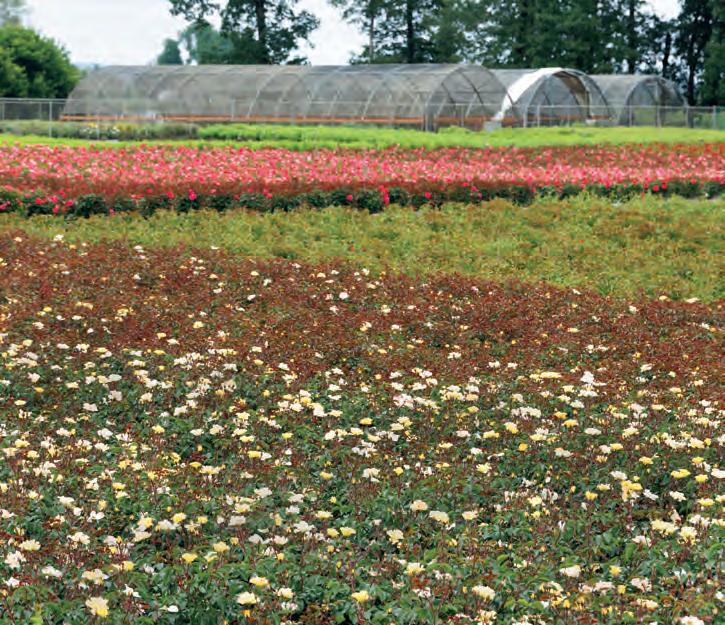
natives can blend together beautifully in the landscape.”
Brighter color palettes and interest in pollinators continues to be on the rise, as well as a natural-looking landscape aesthetic Monrovia has dubbed ‘the modern meadow.’
With its 100th birthday next year, it’s turning to its history for inspiration. “We’re working on a collection of plants that have really transformed the landscape in North America over the last one hundred years. We’re doing research and asking gardeners and landscape professionals about our plants that they’ve loved and why.”
Though its 100th birthday celebration promises to commemorate its impressive history, if Monrovia’s legacy has proved anything true, it is that it’s already planning how it will revolutionize the industry over the next hundred.

On college campuses across the country, students and groundskeepers work together toward a pesticide-free future
In 2017, UC Berkeley student Mackenzie Feldman arrived at beach volleyball practice to warnings from her coach. If the ball rolled off the court, the athletes shouldn’t chase it; the area surrounding their volleyball court had been sprayed with a glyphosate-based product that could make them sick. Feldman was from Hawaii and had grown up aware of the dangers of the agrochemical industry. At her coach’s words, alarm bells started ringing. In response, she and a fellow teammate, Bridget Gustafson, approached the grounds maintenance team to request they stop spraying by the courts. The grounds maintenance manager promised to refrain from
spraying near the courts if in return the beach volleyball team would hand pick the weeds in that area; the girls agreed.
But it wasn’t long until Feldman realized that it wasn’t just the courts that were being sprayed with glyphosate, but areas all around campus were being treated with toxic herbicides. They needed a larger solution than hand weeding. Feldman and Gustafson started a student movement to stop the use of herbicides on campus.
The students’ efforts resulted in a grant to bring in a natural turf management expert who worked with the grounds maintenance team to start pilot programs that focused on transitioning two of the major green
spaces on UC Berkeley’s campus to organic. These pilot sites were so successful, the grounds team at Berkeley decided to expand those practices to the rest of campus.
After Feldman graduated in 2018, she sat in on the trial of Dewayne “Lee” Johnson, a groundskeeper who developed cancer from spraying the same chemical that had been used on the girls’ volleyball court, and who sued Monsanto in a groundbreaking trial. Inspired by his story, Feldman launched Herbicide-Free Campus and expanded the work to the rest of the University of California system.
Once momentum grew within the UC system, the campaign expanded nationwide. “That’s when I got involved,”
says Sheina Crystal, co-director of Re:wild Your Campus. “I was a student at UC Santa Barbara, and I worked with other students across the UCs to push the UC system to ban glyphosate and reevaluate their chemical use policy when it came to grounds maintenance.”
In 2022, the Herbicide-Free Campus team joined the Re:wild brand family and rebranded to Re:wild Your Campus, a change which Crystal believes emphasizes the value being added to college campuses when they make the shift away from toxic pesticides.
“We wanted to focus less on what we were removing and focus more on what we’re adding. Yes, we’re removing chemicals, but we’re also adding biodiversity. We’re adding practices that are healthy for humans and the environment. The issue of chemical use can be divisive. We don’t want to end
up in a space where we’re arguing with people about the harms of chemicals. Instead, we’re saying these are all these proven benefits of eliminating them,” continues Crystal.
Since then, Re:wild Your Campus created the Green Grounds Certification to aid students in their conversations with groundskeepers and to give schools across the country a benchmark to work towards. With four levels (Bronze, Silver, Gold, and Platinum) the certification seeks to not only recognize schools already pioneering the transition to organic landcare, but serve as an incentive for other institutions of higher education to join the movement.
YES, WE’RE REMOVING CHEMICALS, BUT WE’RE ALSO ADDING BIODIVERSITY. WE’RE ADDING PRACTICES THAT ARE HEALTHY FOR HUMANS AND THE ENVIRONMENT
To be awarded the Bronze level certification, 50% of the managed area of campus grounds need to be maintained without synthetic pesticides, Silver is 70%, Gold is 90%. At the Gold level, the campus must not be using synthetic fertilizers. At the Platinum level, it is 100% of grounds maintained without synthetic pesticides.
“Groundskeepers don’t often get recognized for the work that they’re doing. It’s a very difficult, arduous, physically demanding job, and they often are overlooked by the students and the administrators. Many might feel as if the sustainability department is always telling them they’re not doing
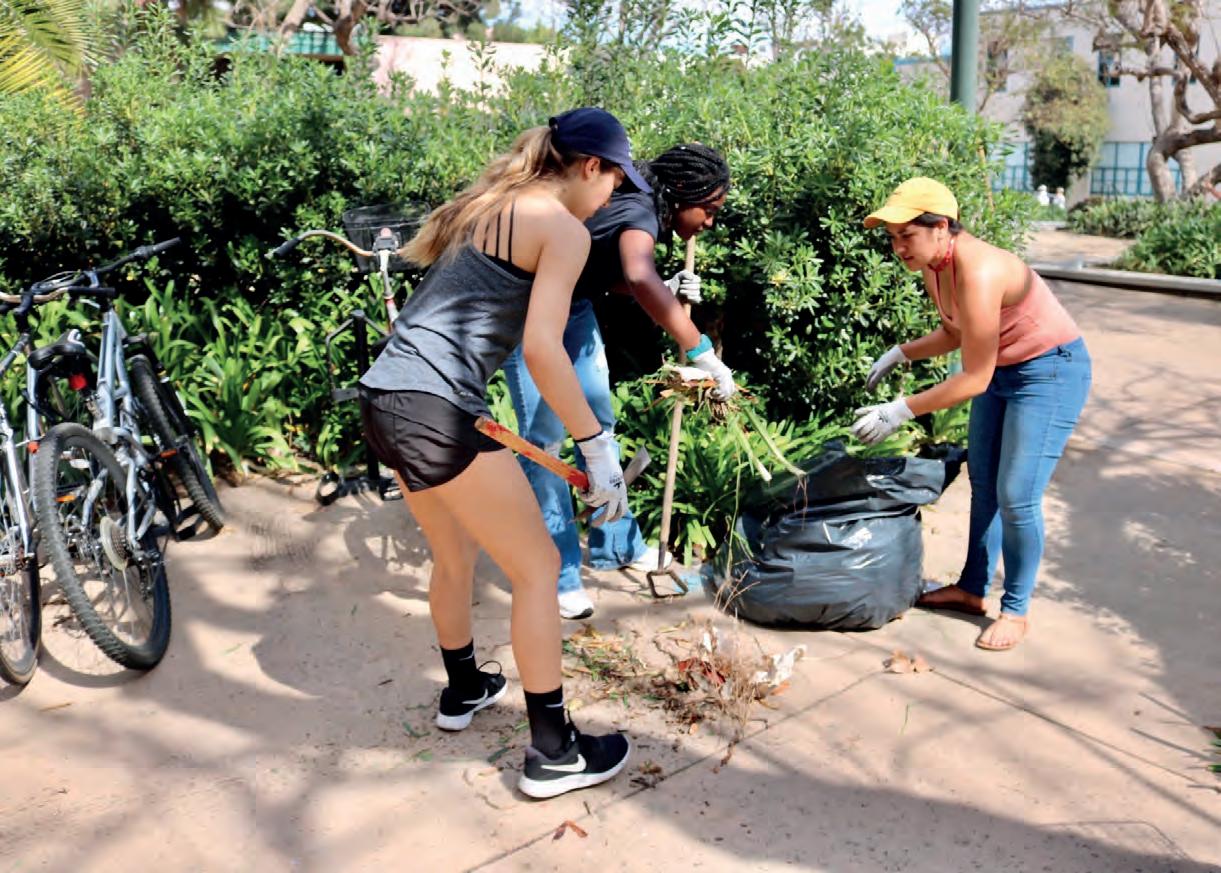
enough. The admin is always telling them they’re not doing enough. Students are complaining that they’re not doing enough,” says Crystal.
“We created the Green Grounds Certification in part to recognize the work groundskeepers are doing, and to start this conversation from a point of trying to say look at all this great work you have done. Look at the way that you’ve managed to get to this Bronze level, let’s use that as a positive point to springboard into further action.”
In February, UCLA became the first campus in California to be awarded a Green Grounds Certification when it received a Gold certification. It was the 10th school to be certified.
“They manage 95% of their campus grounds without synthetic pesticides, and they’ve made a huge effort to actually convert a lot of their lawns to native plants. I think they’ve done a great job of not only limiting pesticides but also shifting the aesthetic when it comes to what is considered beautiful landscaping on campuses,” says Crystal.

campus, right?” says Crystal. “It’s not thought of as like an atypical college campus. So, when we can talk to schools who say to us ‘oh we could never go organic, we have such high aesthetic expectations, we could never stop using pesticides’ we can turn around and explain that schools like UCLA are doing this. It helps to break that narrative that it’s impossible.”
The path to the Green Grounds Certification can start with Re:wild Your Campus’ pilot programs. For most schools, the biggest barrier in transitioning away from chemical use is knowing where to start.
UCLA’s certification helps to lead the way forward for other schools, notes Crystal.“Part of why the certification is so important is because people think of UCLA as having a beautiful
organic land management plan. The team then works together over the next two to three years to overcome challenges and troubleshoot problems, whether that be weather or any other unexpected roadblock.
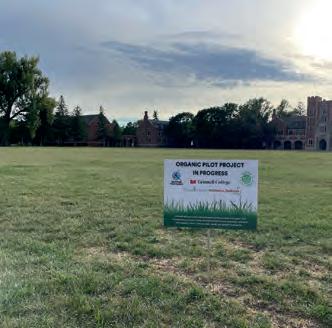
“Grounds staff often lack the knowledge of how to maintain campus grounds to the same highest expectation that they’re currently managed to without the synthetic inputs,” says Crystal.
“The pilot program is the way that we train groundskeepers in how to do that. We work with the grounds team and the sustainability staff to identify two to four pilot sites on campus, and we bring in an expert in organic turf management who analyzes soil test results taken from these sites and creates a comprehensive

The team’s focus is on the pH of the soil and microbial activity. “We look at how we can kind of maximize the health of the soil, bring life back into it, especially if it’s been treated with a lot of chemicals. The goal of the organic pilot program is to educate groundskeepers through these sitespecific programs on how to cultivate soil health, and through that grow really healthy grass, with the goal of expansion beyond the initial pilot sites.”
However, these programs wouldn’t be possible without the dedication of engaged and informed young people. “It is such a crucial part of our work educating young people, training them, and then collaborating with them as they make change on their campus,” says Crystal.
Twice a year Re:wild Your Campus hosts an ‘advocacy bootcamp.’ “It’s a twoday virtual program. We spend the first day talking about pesticides. We discuss the history of pesticide use and how they came to be so prevalent in our modern society, and the ways that pesticides impact our air, water, food, climate systems. And then we spend the second day teaching the basics of community organizing through the lens of the pesticide issue, so how students can start a campaign, identify key stakeholders, do outreach and communicate effectively with those involved.”
The ultimate goal of the bootcamp is to have students start a campaign on their own campus. This January was their best attended bootcamp yet. Through the bootcamp and through
Previous page: Re:wild student led prairie grass restoration project at Grinnell College, Iowa
Current page left to right: Students and groundskeepers at a weeding day at Loyola Marymount University; Organic pilot project sign at Grinnell College in Iowa
working with Re:wild Your Campus, students gain vital skills that they hope to carry with them after graduation.
“My work with RYC at UW-Madison has included grant applications, networking, community outreach and education on the benefits of organic landscape management and native landscapes,” says Hannah Stahmann, a student at the University of WisconsinMadison. “I know that these skills will help me in my future endeavors, and I am grateful for the opportunity to work with a nonprofit that aligns so much with my passions.”
“It was really rewarding to be able to make a difference environmentally while still in school, and it was interesting to learn about the logistics of how environmental changes like these take place,” says Keira Earley, a student Drexel University. At Drexel, their RYC chapter has grown to have impact beyond just campus grounds.
“Our RYC chapter is also partnered with an organization called Toxic Free Philly (TFP), that works to ban harmful synthetic pesticides in the City of Philadelphia,” says Earley. “TFP was founded by people who have suffered health issues due to working directly with pesticides such as glyphosate and 2,4-D. Working with the people at TFP allows us to go further than just our campus, supporting the local efforts to ban pesticides citywide. This will benefit the people and the ecosystems in Philadelphia, especially the aquatic life in our neighboring rivers,” notes Earley.
Crystal emphasizes that dangerous pesticide use is not an issue exclusive to college campuses. “If you’re a parent, you should be questioning if your kid’s school is being sprayed with pesticides. If you live in a homeowner’s association, you should question whether they’re spraying the communal spaces with pesticides. This is an issue that goes unseen in our culture, but it’s an issue that everyone can take action on,” she says.
Since Feldman’s experience on the beach volleyball court, Re:wild Your Campus has grown to include 10 pilot programs across the country. Hundreds
of students, administrators, and experts are involved in the organization, and their work protects over 500,000 students annually from exposure to toxic pesticides. The University of California system has since overhauled their pesticide policies. But more than
this, Re:wild Your Campus has brought awareness to an important issue impacting the landscaping community, and armed a generation of young people with the ability to advocate for themselves, their classmates, and their community.
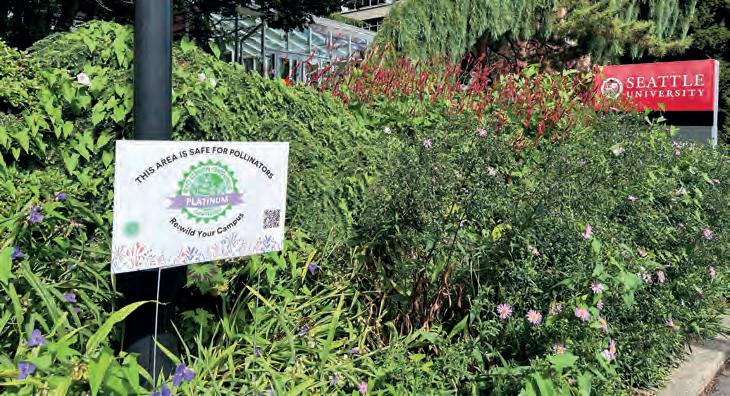
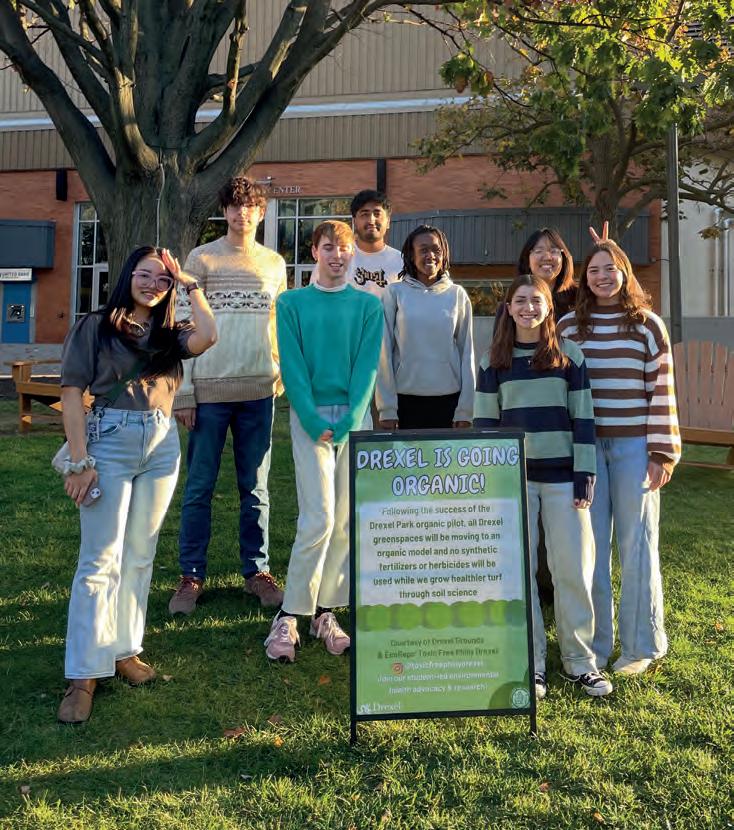
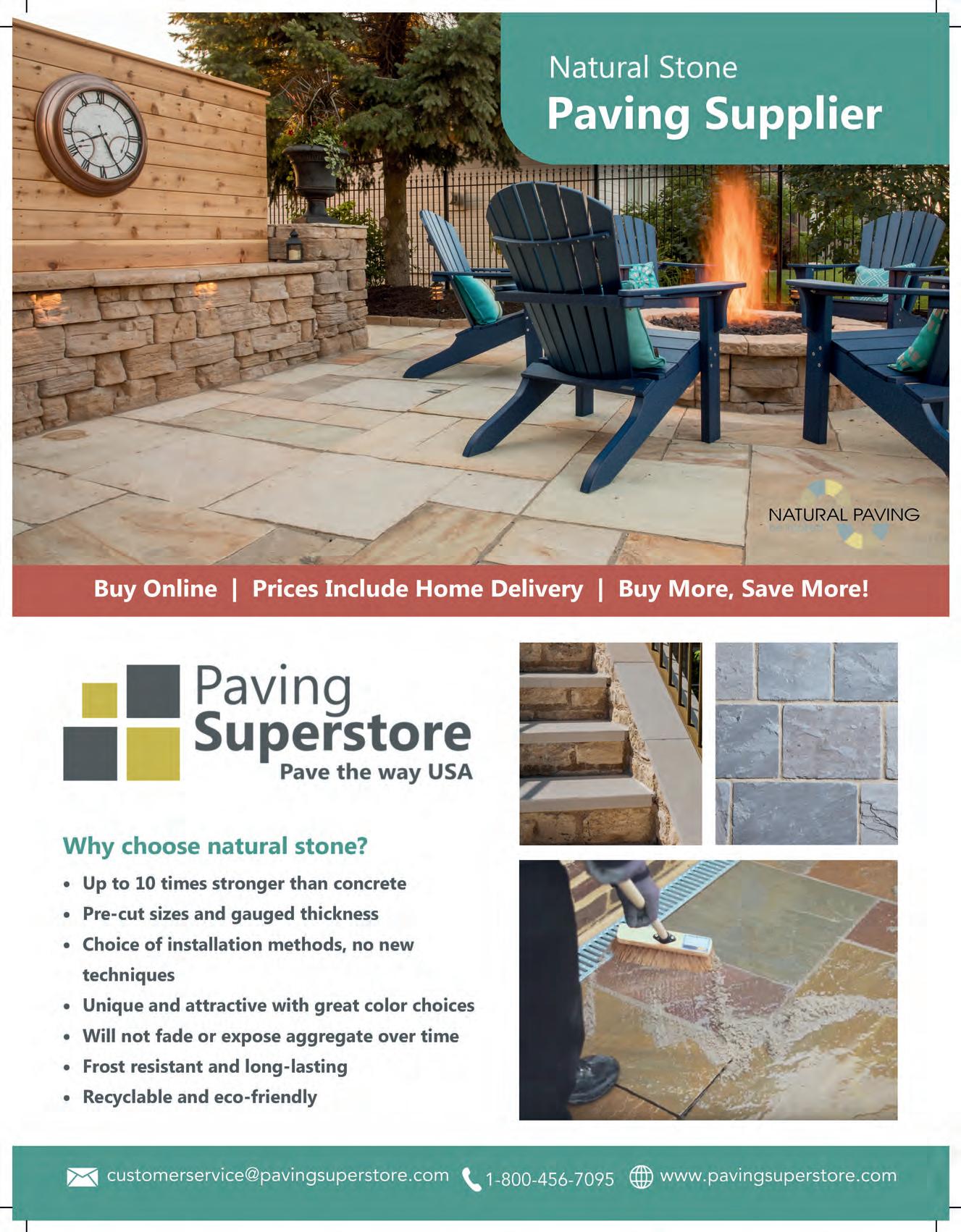


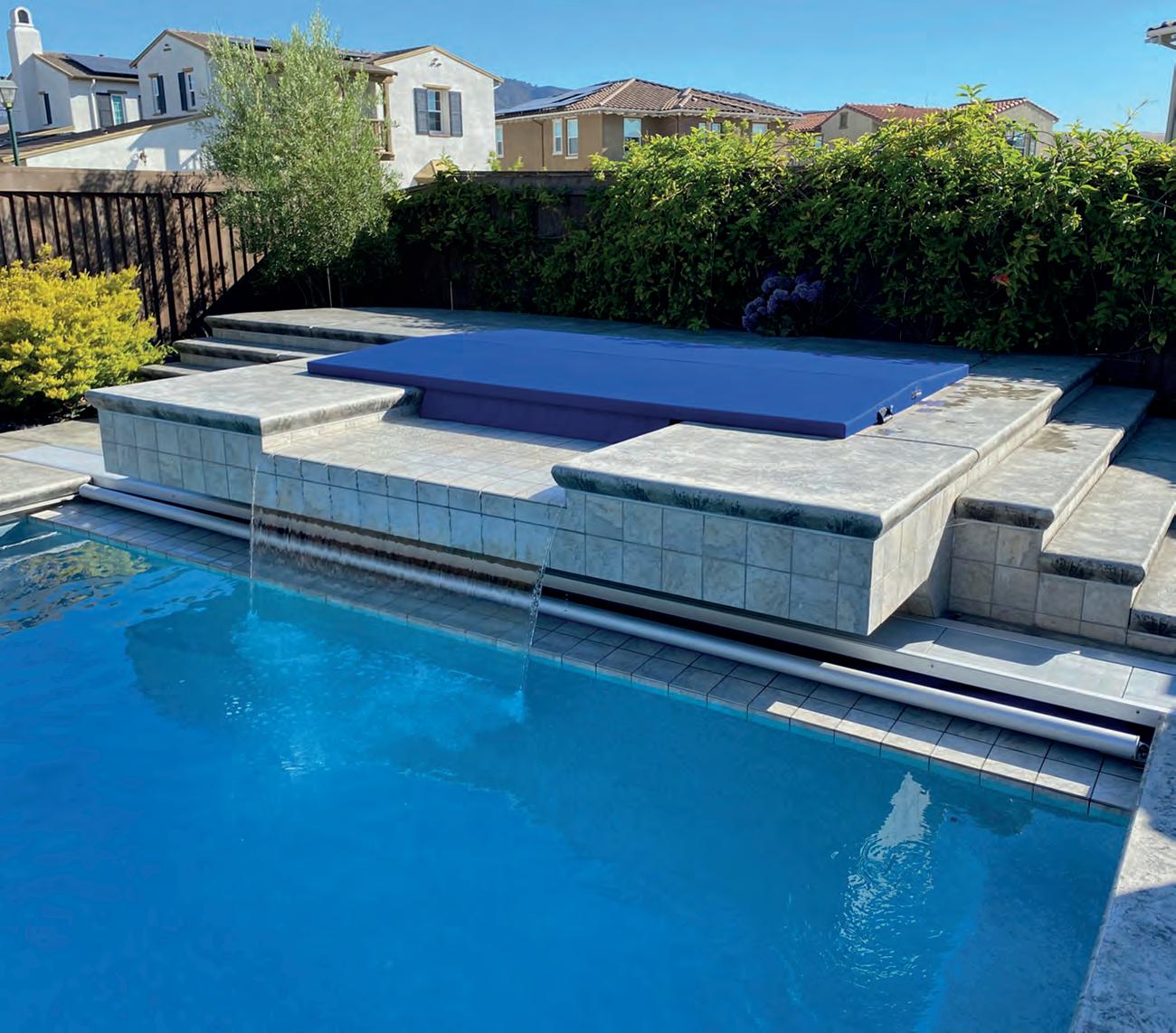

Coverplay, Inc. is inspired to help eliminate toxic foam/vinyl spa covers from entering our environment and from reaching our aquifers, where they could impact future generations. We offer licenses to assemble “kits” with training and ongoing support to those interested in our “Airframe” spa cover, with sustainable technology for the 21st century.
TheAirframe - U.S. Patent # 9340989
A local spa dealer's one month accumulation of water-soaked toxic Styrofoam/vinyl chloride spa covers at a landfill site. Americans toss two million of these annually; this toxic result defies logic when so many use the word “wellness”!
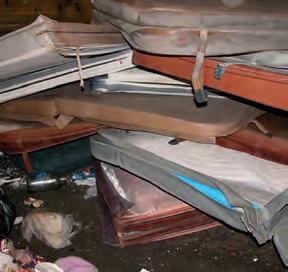
• Environmentally Friendly
• No Harmful VOC’s or Styrene!
• Most Energy Efficient Design
• Repairable, Sustainable, Recyclable
• Doesn’t Gain Water Weight
• Technologically Advanced
• Patented - Energy Test Winner
• Gas Permeable Outdoor Fabric
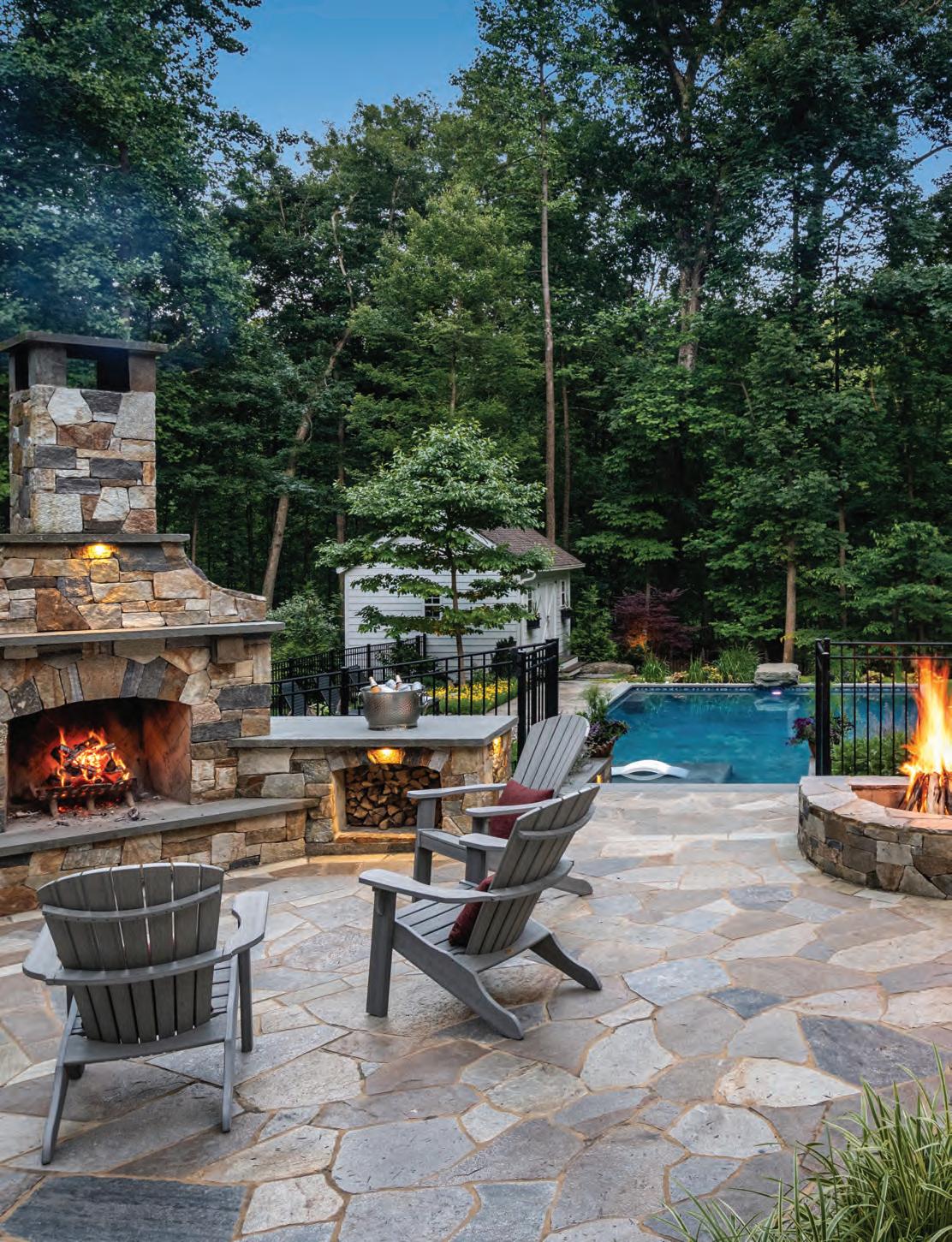
ABSOLUTE LANDSCAPE & TURF SERVICES
MARYLAND RESIDENCE
Absolute Landscape & Turf Services delivers a backyard retreat to be enjoyed all-year round

While many Southern California residents might take the year-round functionality of their outdoor living spaces for granted, the same can’t be said for those living on the East Coast, where wet, chilly weather can send the party inside. But when these Maryland-based clients approached Absolute Landscape & Turf Services for help designing their dream backyard, they didn’t want to just use their outdoor space from May to September. Their goal was to be able to enjoy key components of the design like the kitchen space, covered deck, and fireplace, all year round.
The family, which included two young children and two active adults, were
looking for a functional yet visually striking outdoor space that would accommodate both social gatherings and family activities. Absolute Landscape & Turf Services listened to the clients’ concerns and produced a design that focused on creating a seamless transition between the indoor and outdoor spaces, integrating elements such as the custom pool with built-in loungers and stonework patio, so that both the residence and outdoor living space shared the same cohesive and elegant design language.
On the upper level, a stunning fireplace crafted of stone veneer in shades of brown, cream, and gray,
grounds a seating area of Adirondack chairs, and that same medley of colors was used throughout the entire design from the retaining wall on through to the patio and pool area.
A second fire feature adjacent to the main fireplace was added for evening entertaining so that groups can mingle throughout the space. While a pizza oven, grill, and covered seating area make an ideal recipe for dinner parties and
Previous page: Natural flagstone, dual-fire feature layout, and elevated stonework
Current page left to right: Intersection of culinary function and leisure; Vaulted cedar ceiling & crisp architectural lines frame porch; Poolscape at night, with atmospheric lighting
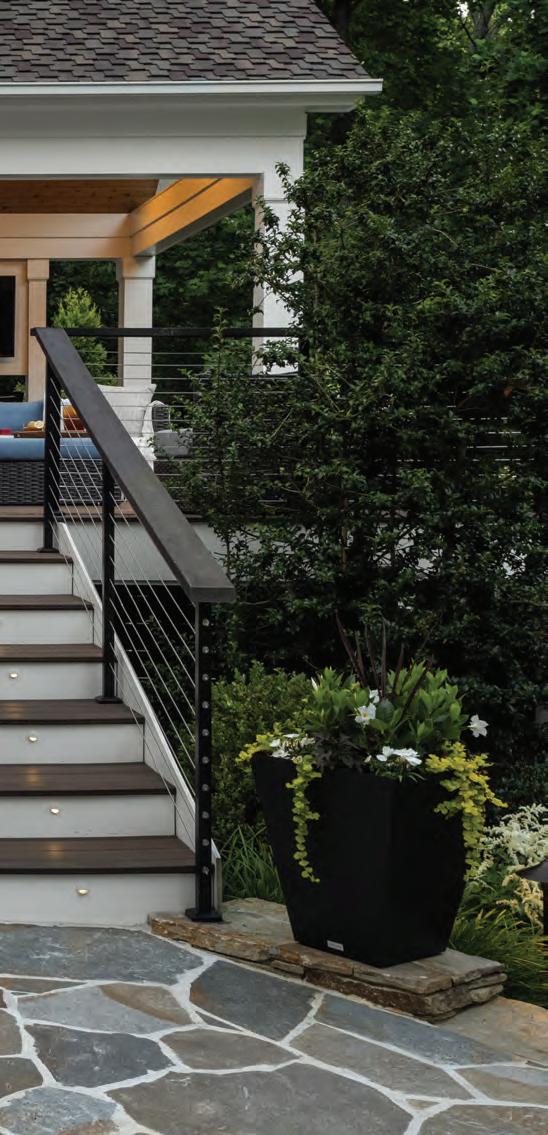
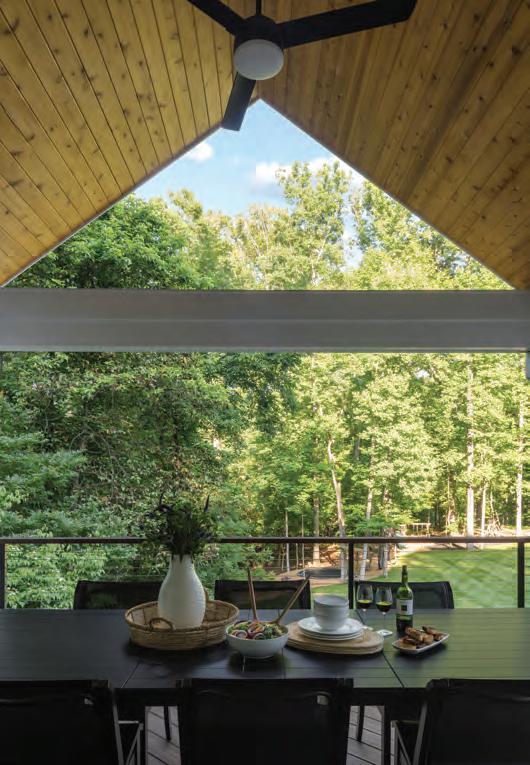
REFERENCES
Appliances
Alpha Pizza Oven alfaforni.com/us
Decking Trex trex.com
Furniture
Ledge Loungers ledgeloungers.com
Lighting FX Luminaire fxl.com
Pavers
Techo-Bloc techo-bloc.com
Residence
Bluehouse Architecture LLC bluehousearchitecture.com
Siding James Hardie jameshardie.com
Stone veneer
D’Amico Stone Quarries damicoquarryinc.com
Patapsco Natural Stone Quarries pnsqllc.com
Styling Cat & Yves Guerra Styling instagram.com/interiorstylingsbycat
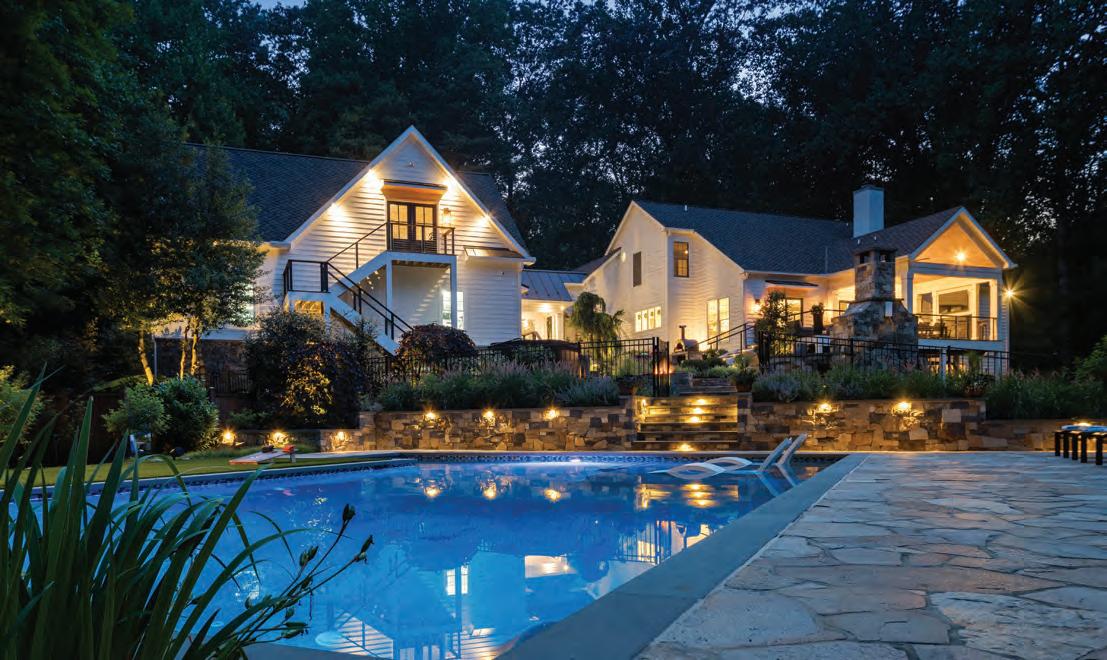

family barbeques. The yard area is the perfect spot for games of corn-hole, and an additional structure offers storage solutions for pool toys and more.
Other key elements include the accent lights which illuminate the pool area, steps, and around the patio for safety in evenings and early mornings.
Deer resistant plants were chosen for use in the softscape to deter persistent animal visitors, and accents of color were added seasonally using annuals.
Though the client’s vision for their backyard retreat might have been clear, the issues surrounding the pandemic and its aftereffects were not quite so straight
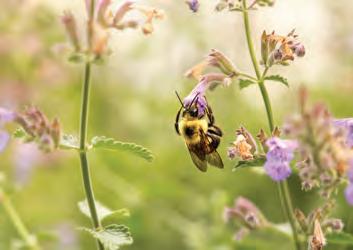
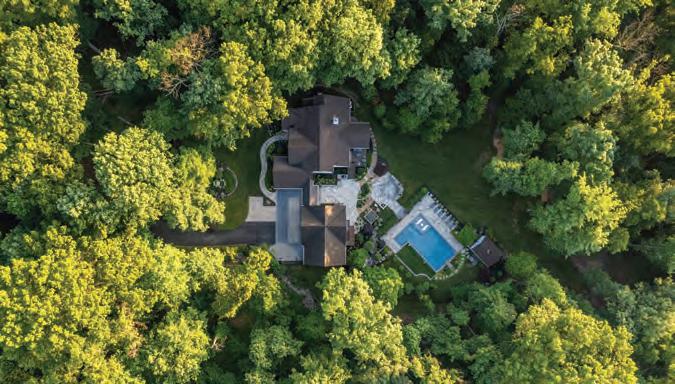
forward. Project timelines slowed due to delays in obtaining permits, while another challenge came from elevation change throughout the yard.
Though the pool contained significant grade change, the problem was solved by the addition of the stone retaining walls and cook space on the upper level, so that the family could descend from the seating area to take a dip in the pool. The team integrated spaces across the property with several elevation changes to a space which naturally flows with the landscape rather than fights against it.
The final product is a project that embraces the East Coast’s seasonality yet offers features that allow for the client’s
family to make memories all year long— whether that’s hot cocoa by the fire in the fall or the summer’s first swim in the pool.
Top to bottom: Fireplace framed by architectural opening; Home sits in lush forest clearing various zones unfolding organically; Biodiverse plantings encourage pollinators
Absolute Landscape & Turf Services is a design, build, and maintenance company founded in 2001 by Matt Sabine. Based in Dayton, Maryland, they service residential and commercial clients. absolutescapes.com
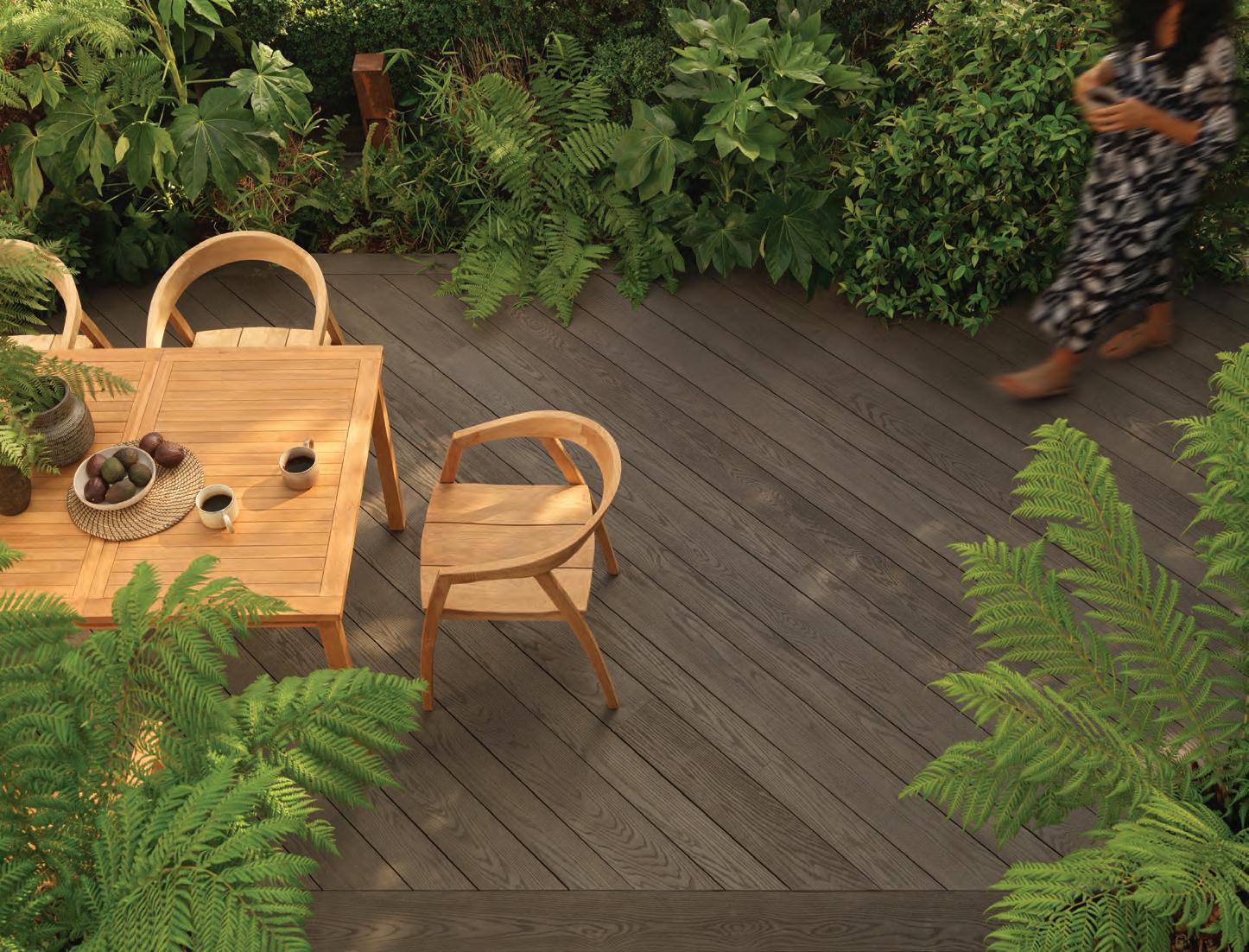
• SOLID BRASS/COPPER
• PRECISION CONSTRUCTION
• PERFORMANCE OPTICS
• LIFETIME WARRANTY
• MADE IN USA
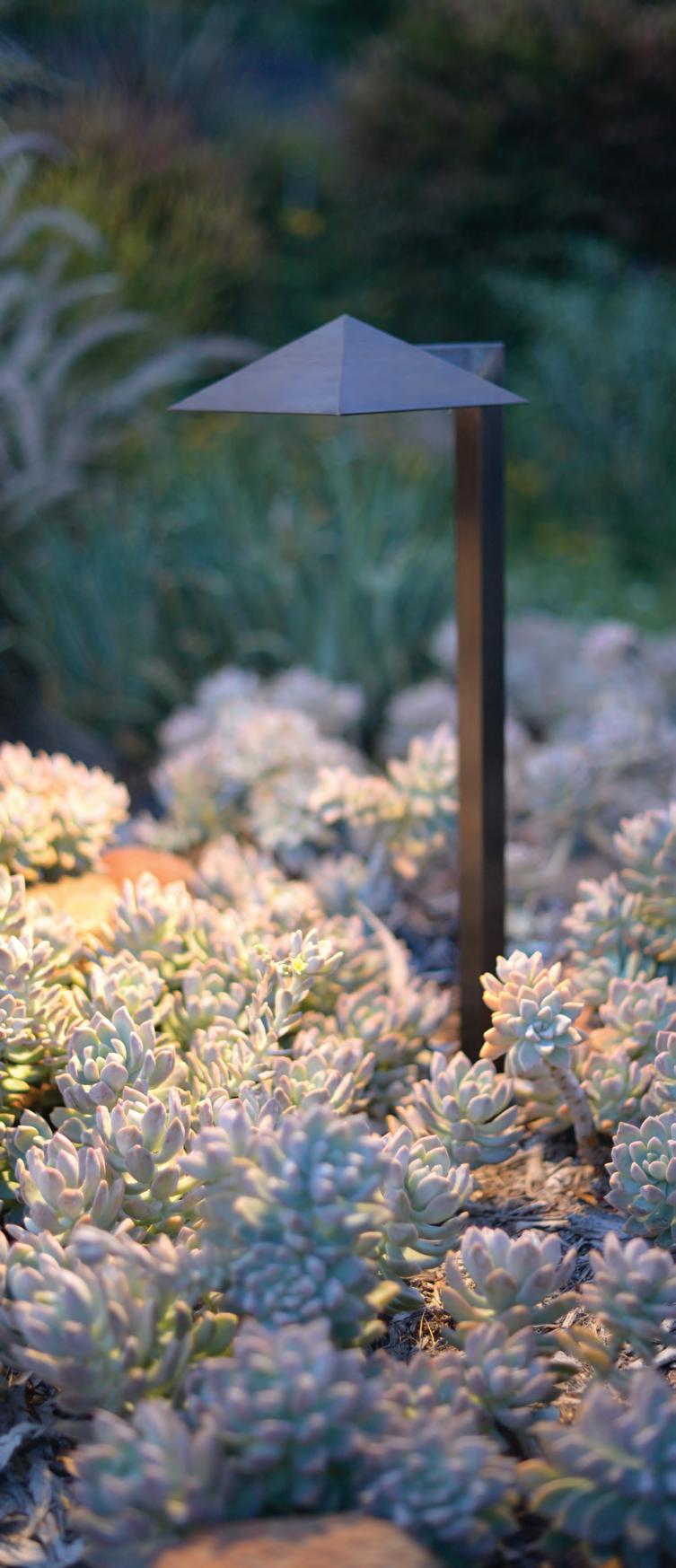
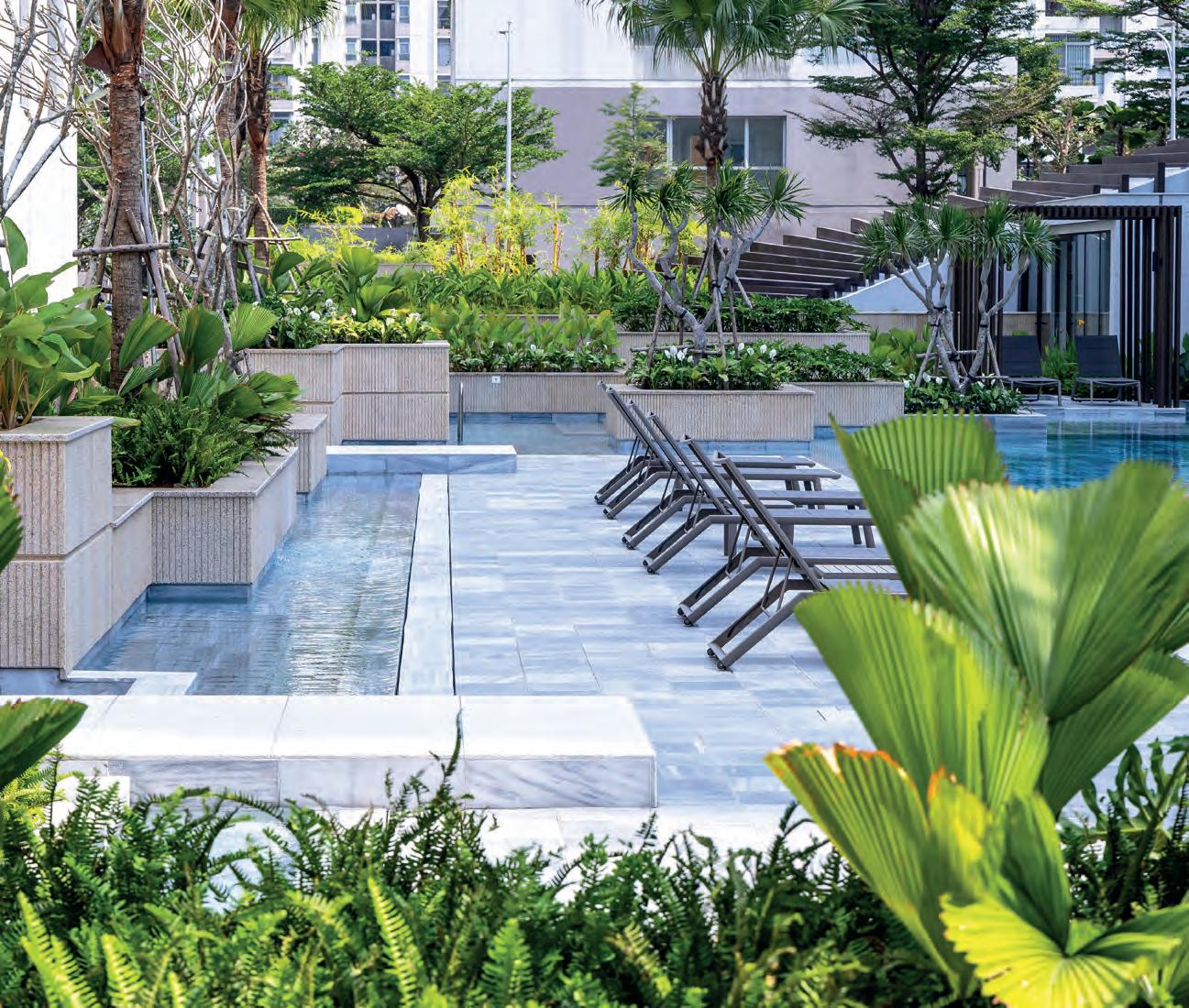
In densely populated Ho Chi Minh City, accessible green spaces for relaxing alone or gathering with friends are essential for offering residents a reprieve from the bustling city.
Located at the heart of South Ho Chi Minh’s central business district, LJ-Group’s Cardinal Court is a mixeduse residential project that features its main common landscape areas on the ground floor.
The client, Phu My Hung Development Corporation, tasked LJ-Group with
bringing a tropical oasis to the city that could serve as a sanctuary for apartment residents, all while seamlessly integrating indoor and outdoor amenities.
The central swimming pool is the focal point of the project, and its sparkling water stands out vibrantly against the surrounding bluestone and granite. Various relaxation spaces border the pool, all sheltered by a multi-layered natural landscape belt. The effect is an
intimate and serene space that creates an organic buffer from the city’s noise and pollution.
The project, which took one year to complete, includes both social areas next to the drop-off entrance and the clubhouse, and more private areas where the lounges and spa are located. The lap pool, kid pool, and BBQ areas serve as the transition between these features.
Not only is it beautiful, but the lush textured vegetation planted throughout the project works to mitigate the heat island effect by retaining rainwater, boosting evaporation, and naturally cooling the area while improving air quality. By fostering biodiversity, the softscaping attracts birds, insects, and pollinators, promoting a healthier ecosystem within urban life.
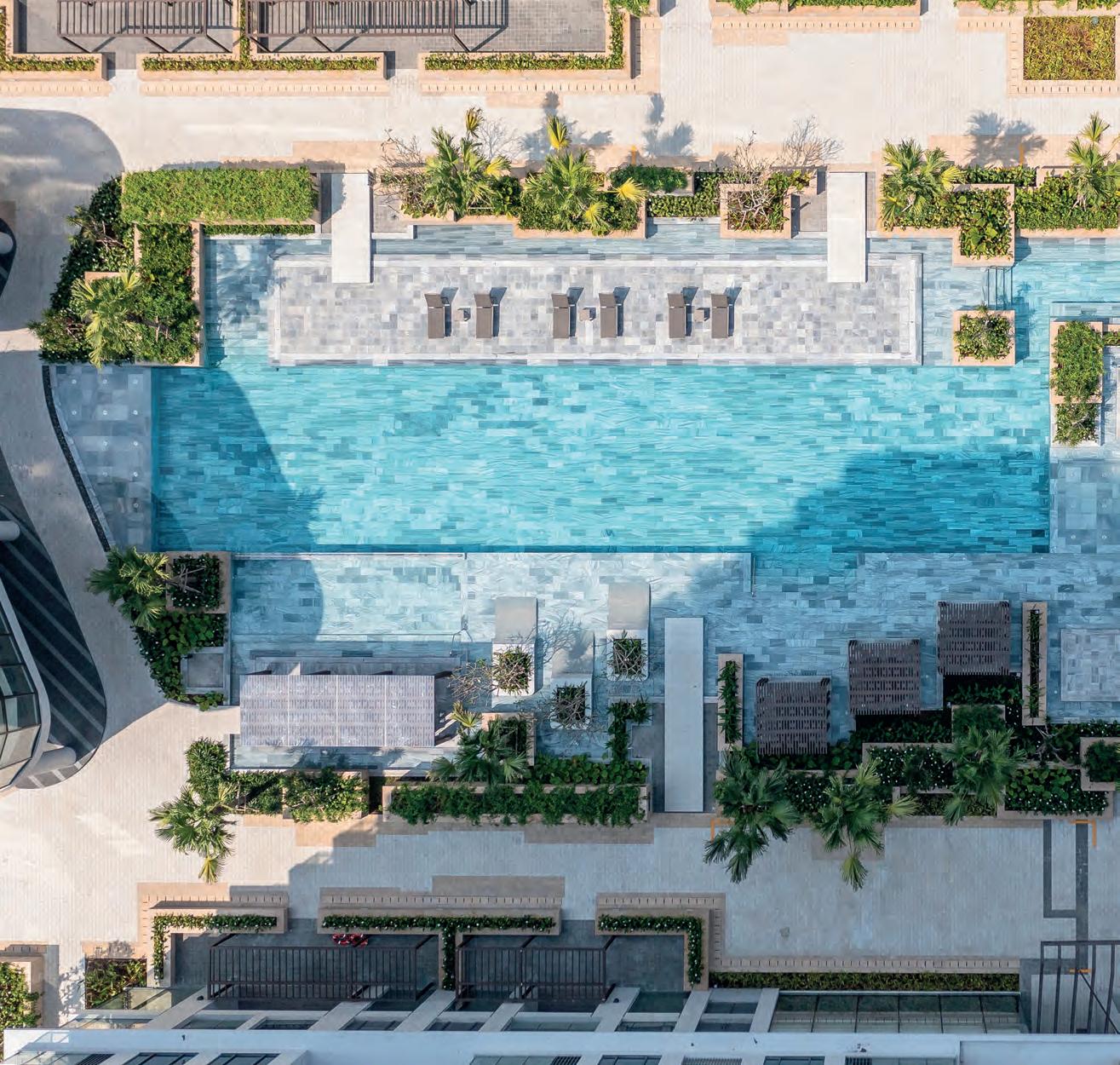

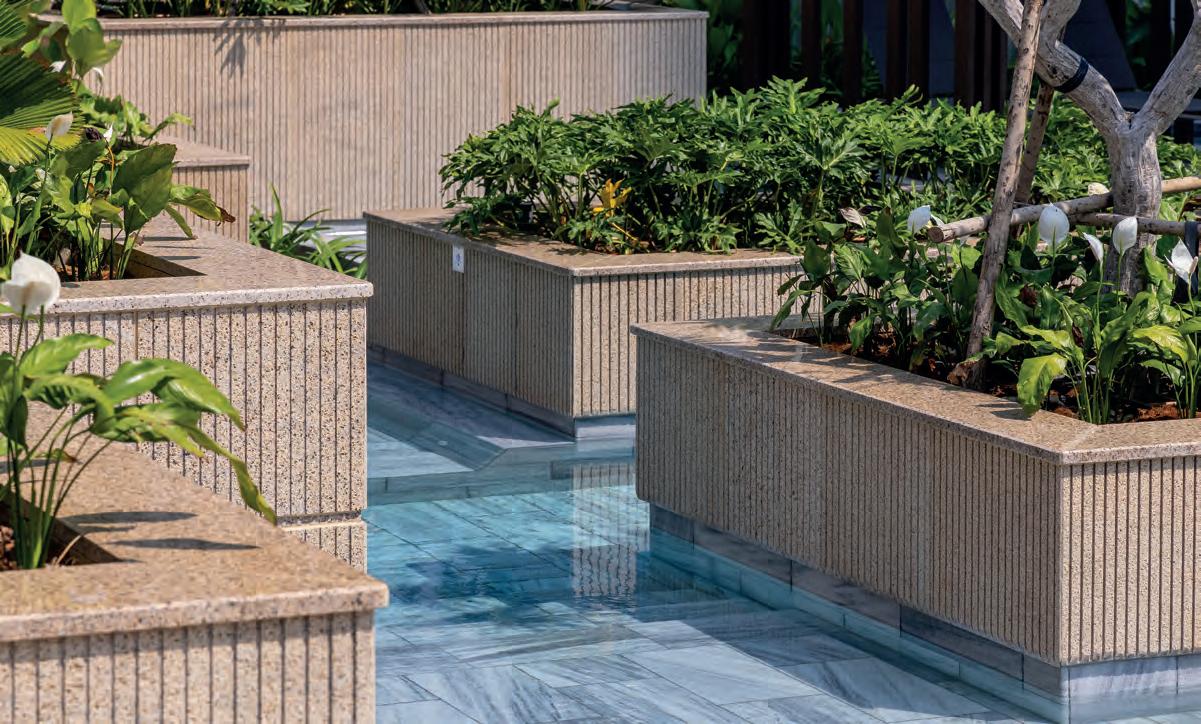
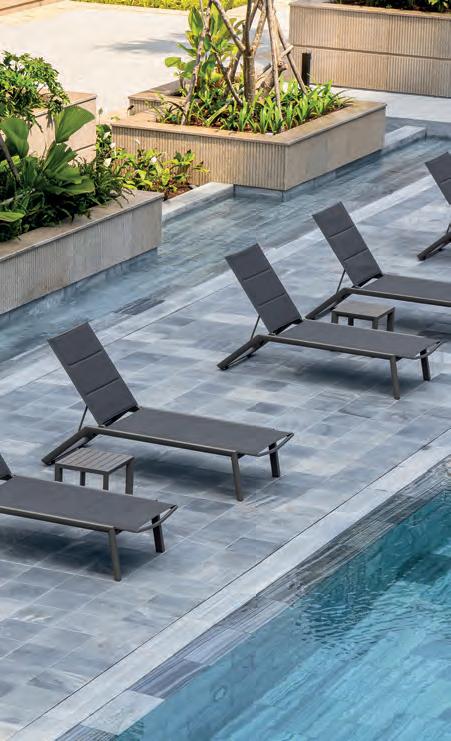
Landscape architects LJ-Group lj-g.com
Landscape lighting design Kobi Lighting Studio kobistudio.com
Architecture and interior design dwp architects dwp.com

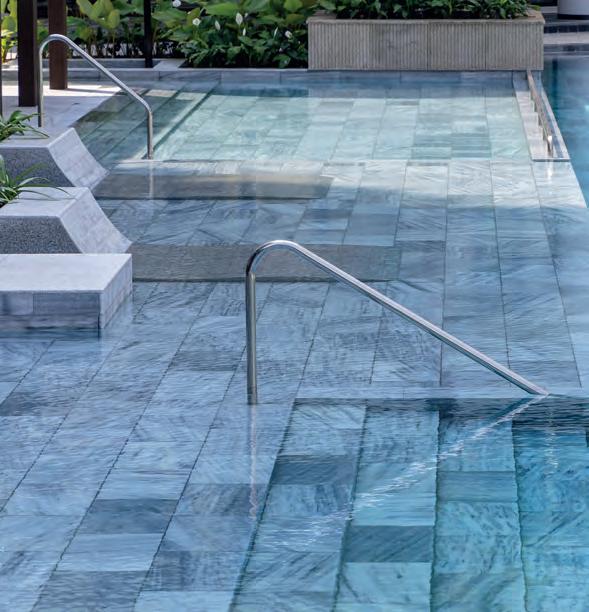
Sustainability was also a key priority for LJ-Group. The project’s use of simple, locally sourced materials, like the bluestone pavers that neighbor the pool, are not only durable and low maintenance but help to reduce the project’s overall carbon footprint.
Cardinal Court has also been recognized for its commitment to sustainability and efficiency, receiving the EDGE certification award (Excellence in Design for Greater Efficiencies). The certification reflects the project’s adherence to international standards, contributing to reduced environmental impact and operational costs. For residents in these high-rise towers, green common areas are not just aesthetically pleasing but integral to enhancing their quality of life. Cardinal Court is proof that integrating nature into a dense cityscape is not only possible, but vitally important.
Top to bottom: Night cabana; Stone sunbed
For over 30 years, LJ-Group has been dedicated to designing modern landscapes for a variety of clients from all over the world. From the first office in Rio de Janeiro, the network has now expanded to well-established branches in Brazil, Vietnam and Portugal.
Our landscape solutions are diverse in scale and type, but always integrate users’ needs with the surrounding facilities and natural environment.
lj-g.com
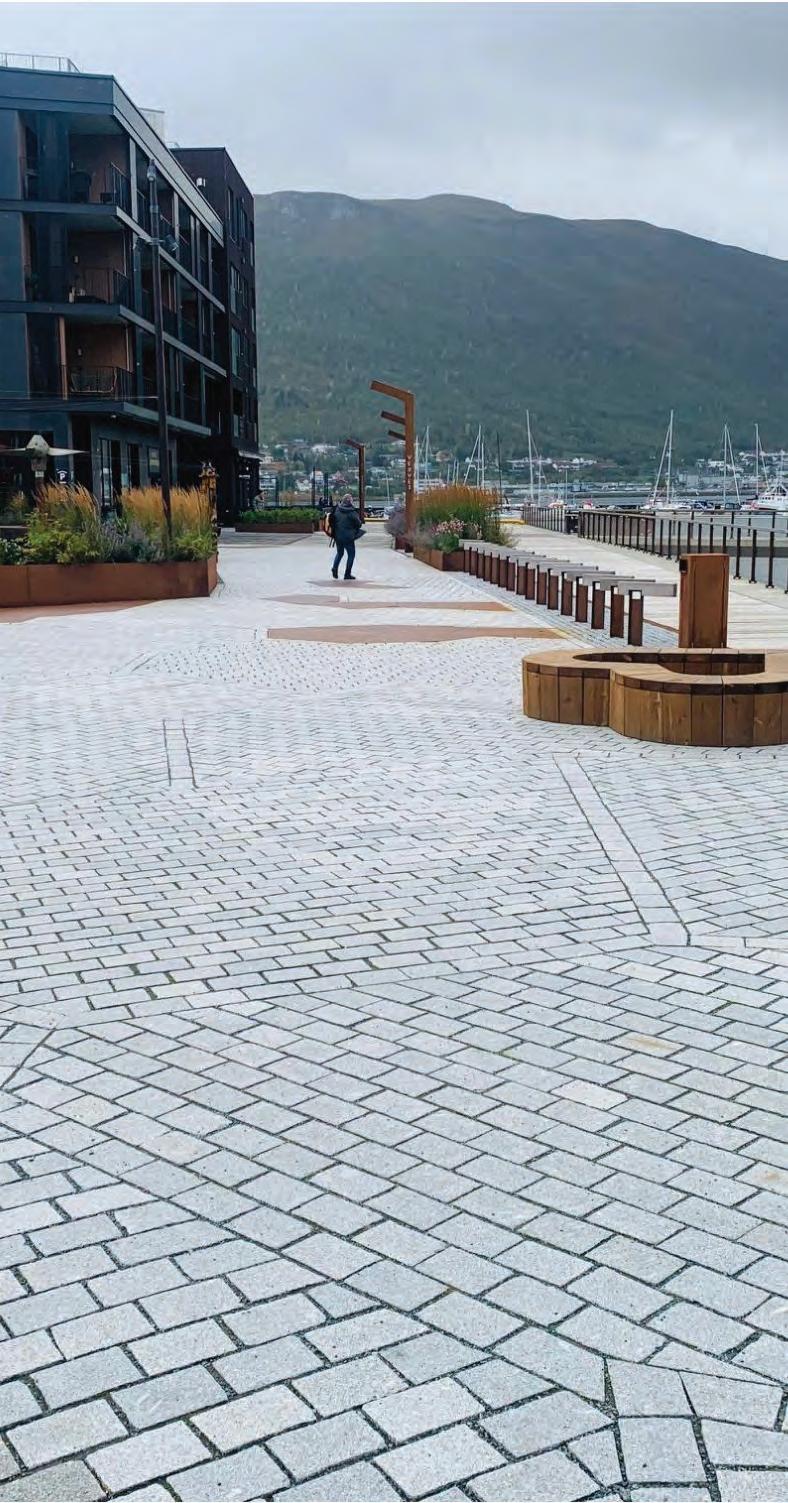







In today’s construction and landscaping industries, innovation isn’t just an option—it’s a necessity. Resin Rock LLC is rising to that challenge, bringing high-performance, sustainable surfacing products to the North American market. With a focus on quality, training, and growth, Resin Rock is setting a new standard for resin-bound aggregate systems across the US.
At the heart of the business is a simple but powerful concept: combine natural stone with advanced, UV-stable resin to create surfaces that are visually striking and engineered to last. From driveways to commercial plazas and municipal pathways, its resin-bound solutions offer strength, permeability, and aesthetic versatility.
What sets Resin Rock apart isn’t just the product—it’s the full-service approach it brings to every partnership. It provides hands-on training and certification for contractors and teams looking to expand their skills and deliver flawless resinbound surfaces.
Through its nationwide distribution network, it ensures clients across North America have access to its premium resin and aggregate systems—quickly and reliably.
It is seeking new distribution partners to join its network. This is an exciting opportunity for builders’ merchants, suppliers, and regional wholesalers looking to tap into one of the fastestgrowing segments in outdoor surfacing.
As cities and developers prioritize sustainable, low-maintenance, and attractive solutions, demand for resin-bound surfaces is booming.
The North American market presents unique challenges and incredible potential. From icy winters to scorching heat, surfaces need to endure serious punishment. Resin Rock’s systems are designed for these conditions, offering:
• Crack-resistant durability even through freeze-thaw cycles
• UV-stable resins that won’t yellow or degrade over time
• Permeable performance, helping reduce runoff and meet local stormwater regulations
• Low maintenance requirements, minimizing long-term upkeep costs
• Wide design options to complement both classic and modern architecture.
In urban settings, its surfaces aid water management. In residential spaces, they offer curb appeal and longevity. For commercial installations, they handle heavy traffic while maintaining a polished appearance.
Its training programs empower contractors with the knowledge to deliver professional, long-lasting results. Whether new to resin-bound systems or a seasoned installer, Resin Rock provides the resources you need—from product education and mixing techniques to installation best practices.
Its distributor support includes marketing assistance, technical documentation, demos, and more.
As cities modernize and consumers demand greener options, Resin Rock is proud to lead a movement toward smarter surfacing. It invites qualified distributors across the USA to join its network and help reshape the future of surfacing in North America.
To learn more or inquire about training, visit resinrockllc.com or contact info@resinrockllc.com or 941-415-0273.
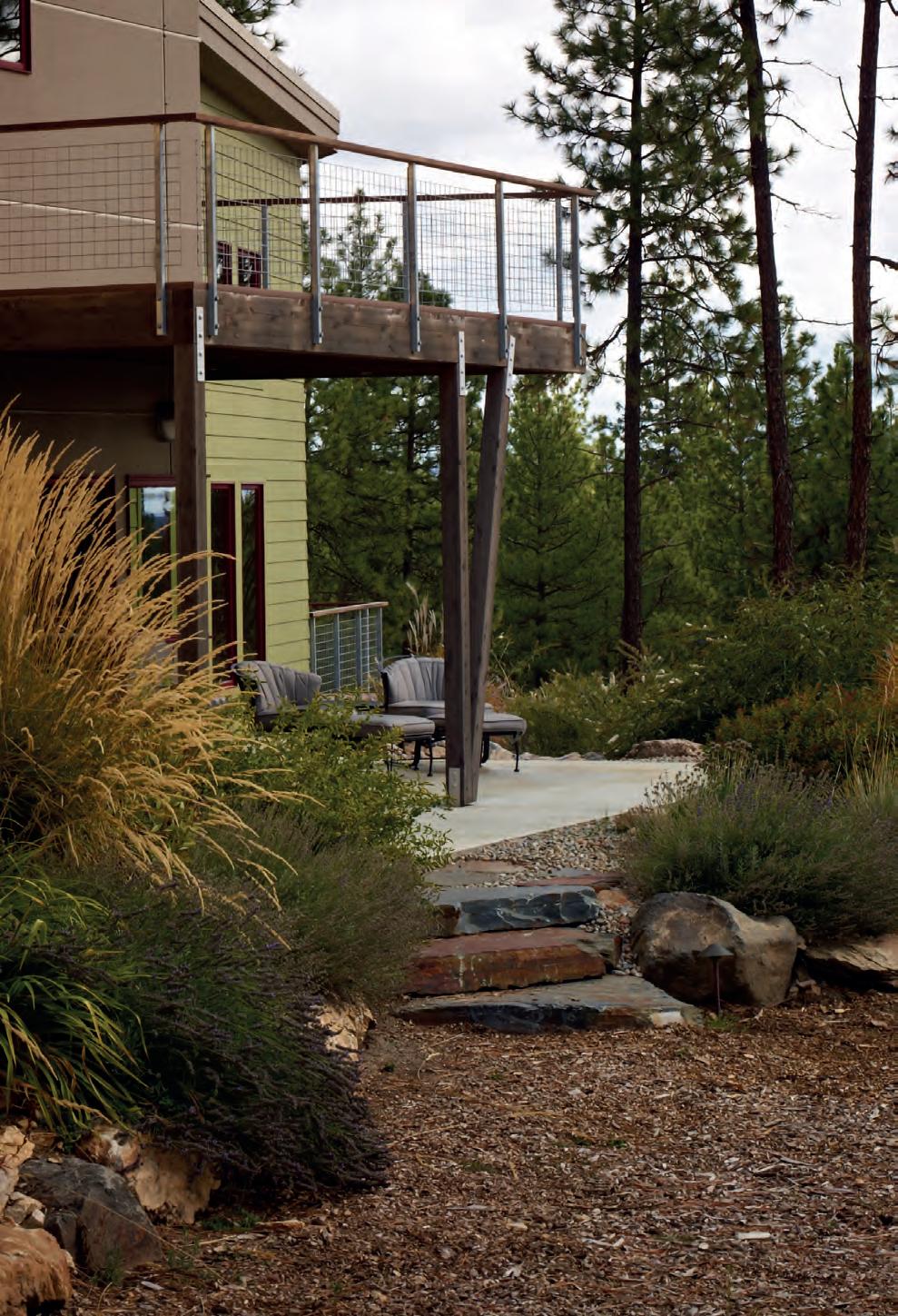
When John Wyer of Bowles & Wyer, a UK based design and build landscape firm, received an email from a couple living in Spokane, Washington urgently requesting his help with their blank slate of a property he was immediately intrigued.
SGLD
Nestled into the foothills of the Rocky Mountains, the site encompasses about 10 acres, though the project would focus on the half acre entrance to the property as well as the acre at the rear where informal planting and grasses merged with wildflowers at the woodland edge.
Wyer flew to Washington for a week to meet with the clients who expressed that their main desire was to integrate the house into the surrounding landscape, as well as incorporate sculpture work and a vegetable garden. During his stay, Wyer spent early mornings exploring the glacial lakes, trails, forests, and mountains nearby to get a sense for how the local landscape worked together; next he visited stone yards, suppliers, nurseries, and finally he approached the clients with a plan.
The greatest challenge facing the project was distance. Because Wyer was

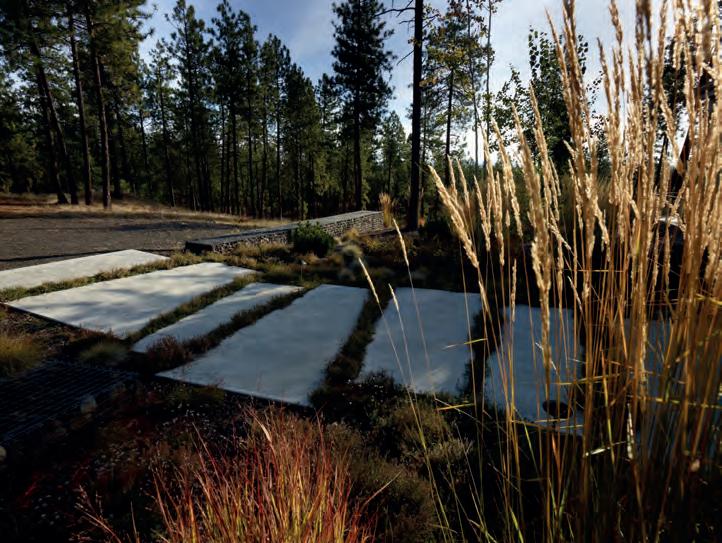

unable to stay in Washington throughout the entire project, many of the technical aspects had to be conducted from afar. However, one half of the client couple had formerly worked on a ranch and was ready to step in to help. The clients did the groundworks, made up and filled the Gabion baskets, and planted the softscaping themselves. The lighting and concrete work was completed by a local contractor.
Other challenges included the dry climate. With approximately 11in of rain a year, half of which falls as snow in the winter, Spokane is also subject to extreme temperature variation—from -4°F in the winter to and up to 95°F in the summer. With the climate in mind, the design incorporated xeriscape planting to accommodate the arid conditions.
Finally, the abundant wildlife caused an unexpected setback when a mother moose and her calf decide to

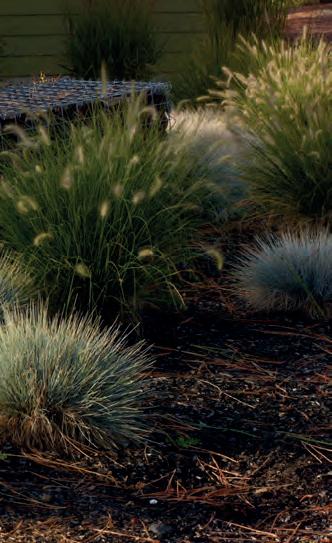

Trees
• Pinus mugo
• Populus tremula
Grasses
• Pennisetum villosum
• Panicum virgatum
• Festuca glauca
• Calamagrostis ‘Karl Foerster’ Perennials
• Thymus serpyllum
• Armeria maritima
• Alchemilla mollis
Previous page: First floor rear balcony with views across forest clearing Current page left to right: Soft grasses contrast with hard geometric lines of wire baskets; Large, asymetric concrete slabs with salt-etched finish; Spiky Festuca & feathery Pennisetum; Patio with scored geometric lines jutting out into woodland; Colours and form inspired by landscape
House architect
Copeland Architecture copelandarchitects.com
SGLD Society of Garden and Landscape Designers sgld.org.uk
BALI
British Association of Landscape Industries bali.org.uk
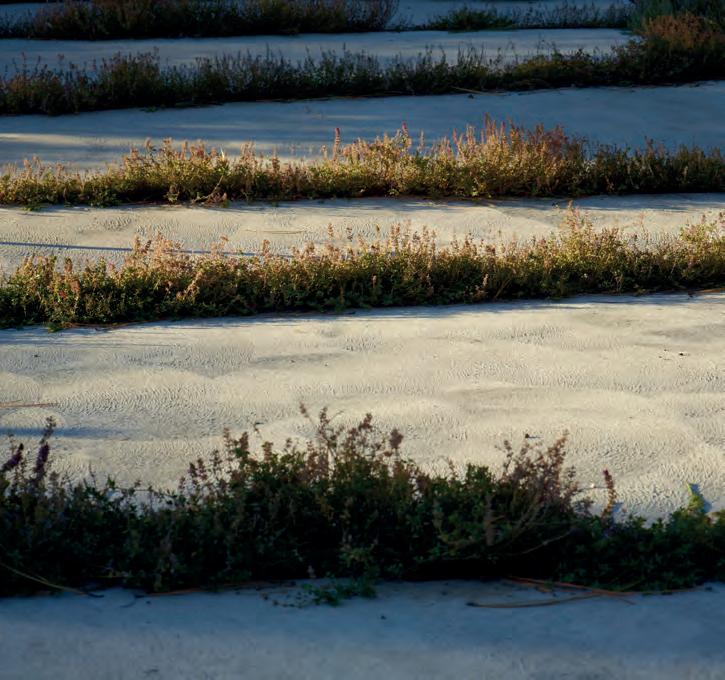
make a meal of the young Aspen trees throughout the project. In the spring, the clients replaced the Aspen with taller specimens, that remained, thankfully, uneaten.
The entrance to the property focuses on two main elements; large slabs of concrete that lead up to the front door with Gabion walls flanking either side asymmetrically. The Gabion walls echo the natural granite outcrops found on the site, as well as mirror the aesthetic of the residence.
The outcome is a project that showcases the extraordinary synergy that can come from a client, designer, and natural landscape working in harmony together. When looking at images of Rocky Mountain Garden, it’s hard not to feel that same sense of inspiration and wonder Wyer experienced on his early morning walks through the Ponderosa pines.
Top to bottom: Thyme between in-situ conrete slabs; New landscape blends into old and anchors the form and colour of the building

Bowles & Wyer design, build and tend landscapes for private individuals, businesses and organisations across the UK and beyond, including public spaces that lift your spirits and gardens that make your heart sing.
bowleswyer.co.uk
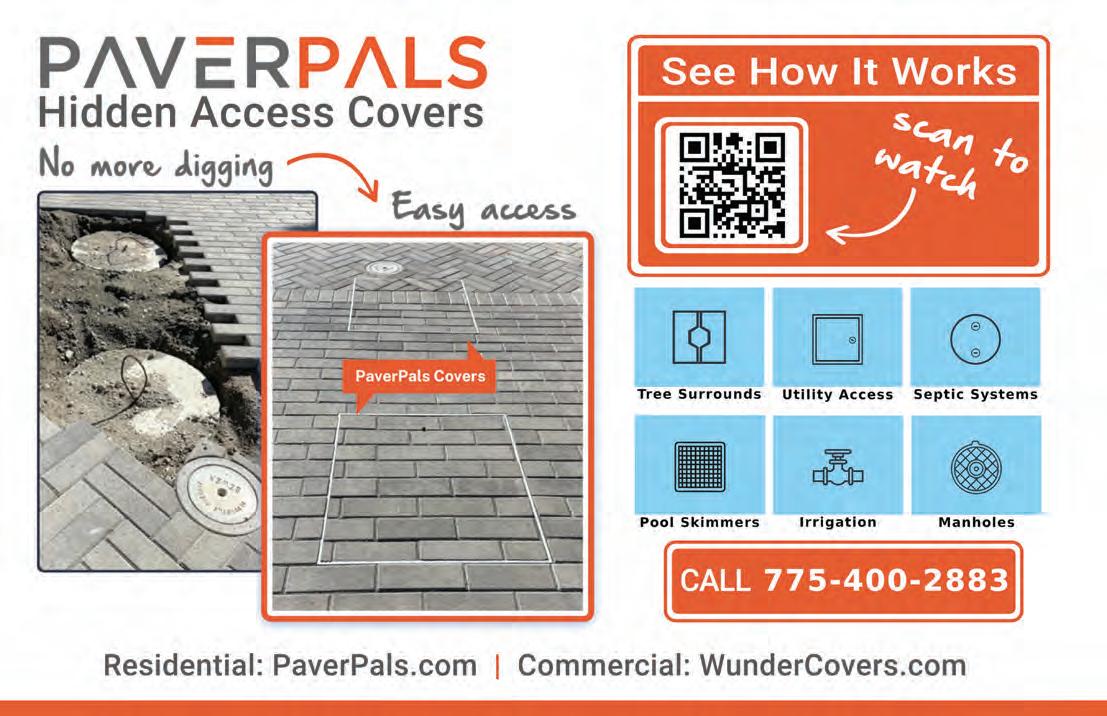













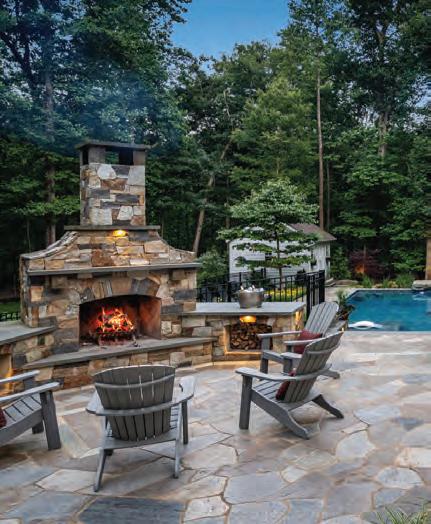




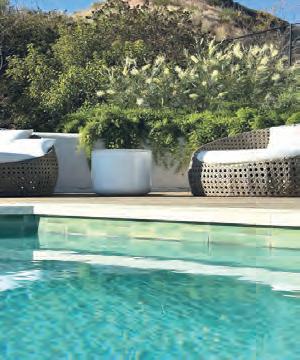































Bruce Read, operations director and chief financial officer of Paving Superstore, shares why natural stone pavers can be a cheaper, more sustainable, and better-looking choice than concrete
While natural stone patio and driveway pavers are all the rage in the UK, they’ve been slower to take hold in the US market. But for landscapers and clients looking for a beautiful, sustainable, and durable product, that is just as easy to install as concrete, natural stone pavers are the way to go.
What makes Paving Superstore the ultimate go-to for homeowners, contractors, and businesses?
Paving Superstore is your premier online shop for high-quality hardscape products, primarily sourced from Natural Paving USA. We cater to a wide audience, including homeowners, contractors, businesses, and designers by offering an extensive selection of durable and eco-friendly paving solutions. Our user-friendly website allows for easy browsing, product comparisons, and informed purchasing decisions. With
a commitment to excellent customer service and fast shipping, we ensure that everyone—from DIY enthusiasts to seasoned professionals—finds exactly what they need for their projects.
What delivery options does Paving Superstore offer to its online customers?
Paving Superstore delivers directly to the door across all of mainland USA, and the prices on our website include delivery. There are no extra costs at all for shipping and delivery—which makes Paving Superstore unique in the US. We offer flexible delivery options tailored to our online customers across the country. We provide reliable shipping services, including LTL (Less Than Truckload) direct to residences, as well as flatbed and hotshot services for larger orders. This ensures that customers receive their products in a timely and efficient manner, regardless of their
location. Our logistics team is committed to managing deliveries smoothly, allowing customers to focus on their projects without delays.
Which hardscape products are in highest demand this year, and why?
This year, our durable sandstone and limestone pavers from Natural Paving USA are in high demand. These products stand out for their impressive durability, boasting an average PSI of 15,000 and a low absorption rate of 1.2%, making them suitable for all climates. Homeowners and contractors appreciate their strength and resilience, as well as the natural aesthetic appeal they bring to outdoor spaces.
Can you elaborate on the ease of installation for contractors using natural stone paver products? Absolutely! One of the key advantages of using natural stone paver products

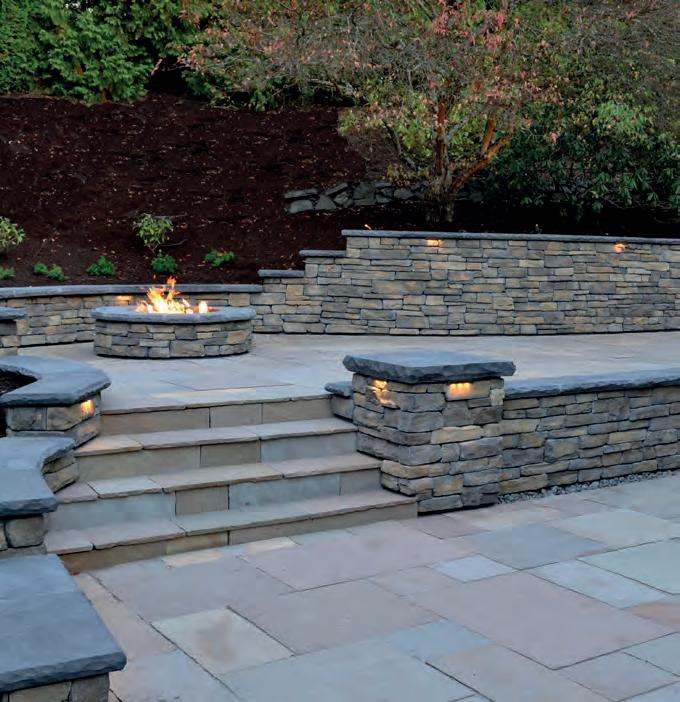
is their ease of installation. The larger format pre-cut and gauged thickness pavers allow for quicker installation, which translates to reduced labor costs for contractors.
The robust design and lightweight nature of these materials make them easier to handle, minimizing the overall time spent on installation. Using traditional sand set, mortar set, or gravel
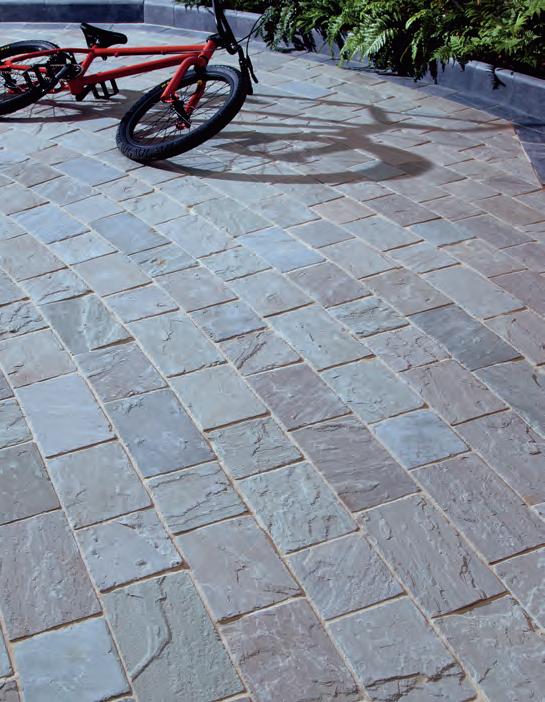
set installation means no new laying techniques are required.
The Classicstone line features a natural chiselled finish, providing a traditional look that enhances the charm of outdoor spaces. In contrast, the Premiastone line offers precisioncut edges for a more contemporary and sleek appearance. This variety allows contractors to choose the right
product for their specific project needs, making the installation process smooth and efficient.
Does Paving Superstore offer bulk discounts in the USA?
Yes, Paving Superstore offers a bulk discount program for customers in the USA. The more you purchase, the lower the price per unit—making it a
cost-effective option for larger projects. Discounts are applied automatically at checkout based on the quantity ordered, so you’ll see your savings increase as your order grows. If you’re planning a substantial project or need a custom quote, feel free to contact our team for tailored pricing support.
What is one trend you’ve noticed customers asking for?
One significant trend we’ve noticed in the paving industry is the increase in demand for sustainability. Customers are far more environmentally conscious than ever before, and they’re seeking out materials that reduce their carbon footprint. Natural stone pavers are a great option when you’re looking at environmentally conscious solutions, because it is always going to be a more environmentally friendly choice than concrete.
Something you wish more customers knew?
One key aspect that we wish more consumers were aware of is the long-term value of investing in highquality natural paving materials. While cheaper options might seem appealing at first, they often lead to higher maintenance costs and shorter lifespans. For example, concrete pavers are known to fade over time and do not give long-term aesthetic appeal. By choosing quality products from Paving Superstore, customers not only enhance the visual appeal of their projects but also ensure durability and sustainability. This is where our partnership with Natural Paving USA shines, offering materials that are both beautiful and built to last, giving customers peace of mind for years to come.
In conclusion, Paving Superstore is not just a place to buy paving materials; it is a community-focused brand dedicated to quality, sustainability, and customer education. The synergy between Paving Superstore and Natural Paving USA creates a powerful narrative that reflects modern values and a commitment to a better future. pavingsuperstore.com
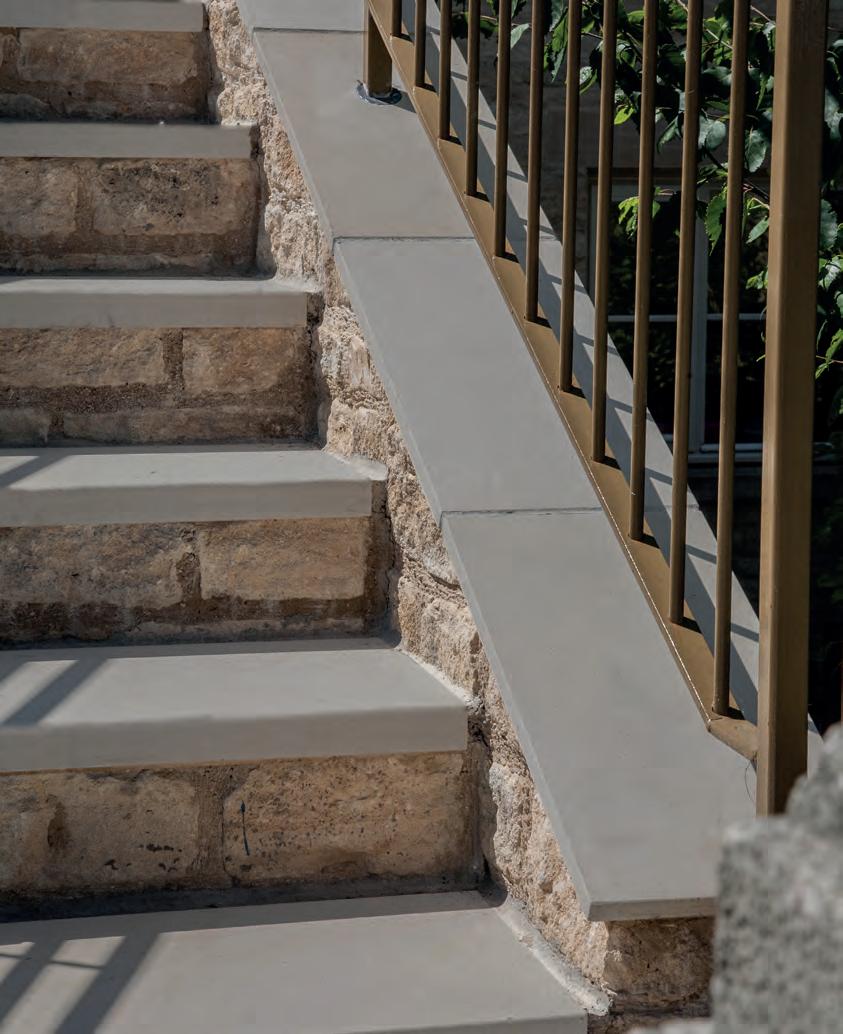

Joe Raboine, VP of design at Oldcastle APG and Belgard hardscapes, shares his key tips for successful paver installation
Installing pavers is more than just a home improvement project; it is an opportunity to enhance outdoor spaces, increase property value, and create lasting appeal. But getting it right requires planning, precision, and an understanding of the materials and methods. Whether you’re a seasoned pro or this is your first paver project, here are some tips for a successful installation.
The most common mistake in paver projects is not taking enough time to prepare the base. Pavers are typically installed on a compacted granular aggregate, which should be between 4”-6” in total thickness. The soil type and application influence the depth of the base layer. The base layer should be leveled and compacted firmly to safeguard against the pavers shifting or settling.
Once the base is in place, lay two-half to three-quarter-inch diameter conduit pipes 3ft-6ft apart on the base, and spread a layer of paver sand. You can use a 2x4 board to level or screed out the sand between the pipes, remove them, fill the pipe beds with sand, and trowel smooth. Bedding sand plays a critical role in ensuring proper interlock between the pavers and allowing for a smooth surface. Bedding sand should be spread evenly across the base material.
various styles and colors of pavers to suit every need and aesthetic. Don’t be afraid to mix and match textures and tones.
Lay your pavers onto the sand using the selected pattern provided by the manufacturer. Be sure to lay out the paver stones one square section at a time while not stepping on the paver sand to disturb the level surface.
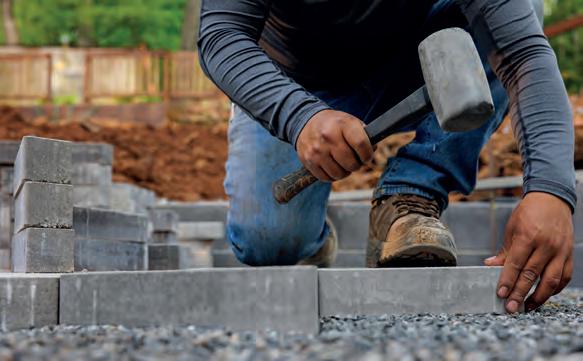

Once your pavers are laid, they must be secured with an edging restraint. Edge restraints are essential to maintain the integrity of your paver layout. Pavers can shift over time without proper edging, leading to uneven surfaces and gaps. Edge restraints keep everything in place and extend the lifespan of your project. Once secured, use dirt or turf to simply cover it.
“EDGE RESTRAINTS ARE ESSENTIAL TO MAINTAIN THE INTEGRITY OF YOUR PAVER LAYOUT”
All pavers aren’t created equal. Consider the space where you are installing. For example, depending on the overall size of the paver, driveways need a thicker, more durable paver than a garden walkway. Consider visuals and using the inside features of your home as inspiration for designing the outdoor space. There are
After laying your pavers, sweep polymeric sand into the joints. Ensure the sand is evenly distributed into the joints. Then use a compacter to compress everything into place. By compacting, you obtain joints that are nearly 20% stronger. This not only fills gaps but also locks your pavers in place and helps keep debris and weeds out. Unlike conventional sand, polymeric stays in place. It softens when wet and firms up when dry to better resist soil movements.
Finally, wet everything down with a hose to activate the binding agents. This process is the finishing step to ensure durability and low maintenance so you can properly enjoy your new paver installation.
While homeowners can successfully complete smaller paver projects, larger or more intricate designs may benefit from a professional touch. Even if you’re an outdoor professional looking to get into hardscapes, don’t be afraid to talk to a seasoned hardscaper for tips as you learn a new skill to put under your portfolio.
As more outdoor spaces are now a true extension of the home, quality outdoor products and how they are installed can transform a simple yard into an inviting retreat. With the right materials, methods, and design planning, your next project can be both aesthetic and built to last.
Bringing you the inaugural
December 9 - 10, 2025 | Los Angeles Convention Center
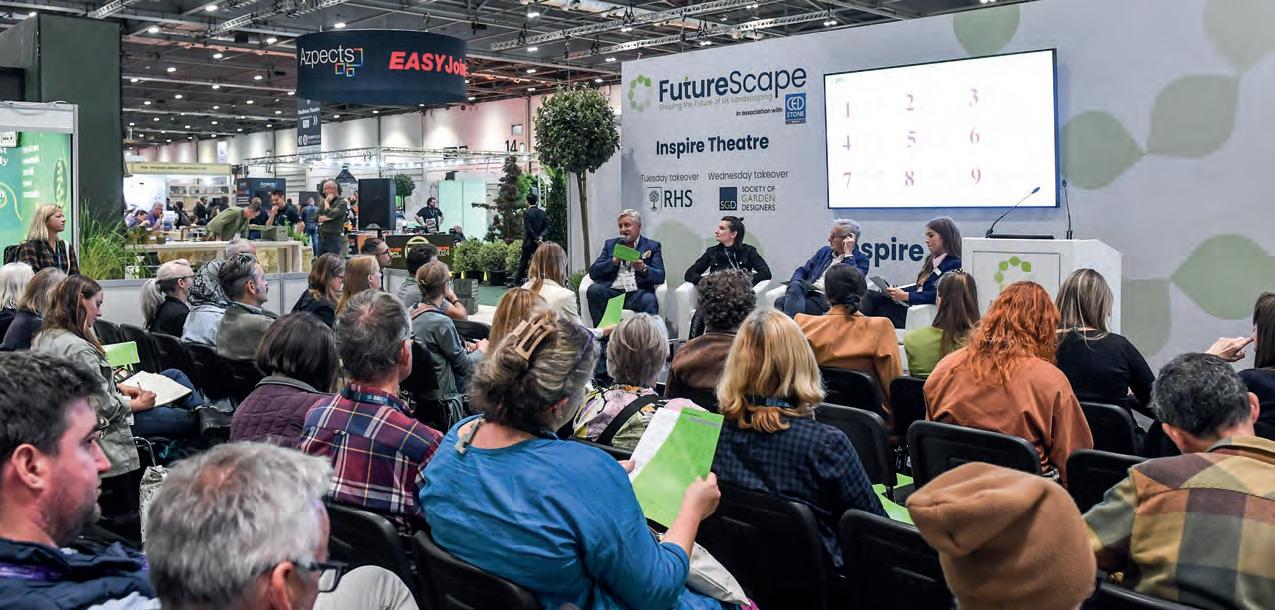




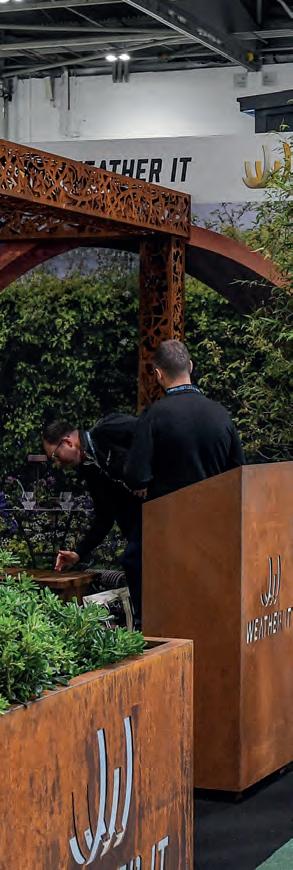


Paving Superstore
Natural Paving ‘Classicstone’—Golden Fossil
Riven natural sandstone has the beauty and hard-wearing qualities of real stone which adds a timeless appeal to any landscape. The colors and textures have formed naturally since time began which give each skillfully crafted piece its own wonderfully unique qualities. This hand split naturally riven paving has hand-cut edges.
Golden Fossil has shades of light buff, gray and occasional bronze. Some pieces of stone may show fossil imprints. pavingsuperstore.com/paving-slabsclassicstone-golden-fossil-naturalsandstone-with-a-cleft-finish.html
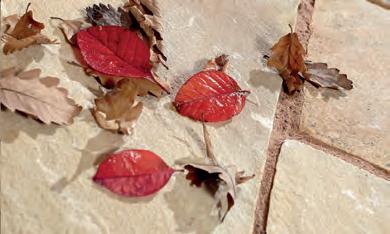
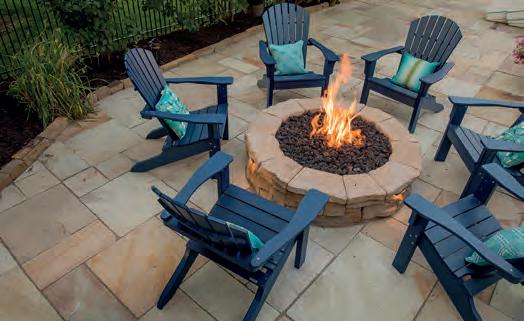
Techo-Bloc
Terrazzo Collection
Techo-Bloc’s Terrazzo Collection answers the growing demand for that classic terrazzo flair—now trending in modern hardscape design. Its all-in-one system of slabs, steps, wall caps, and pool coping offers a factory-applied protectant to resist de-icing salts and stains. Contractors can now deliver LEED-friendly, stylish surfaces in three modern colors that redefine patios, walkways, and pools. techobloc.co/43ysJU8
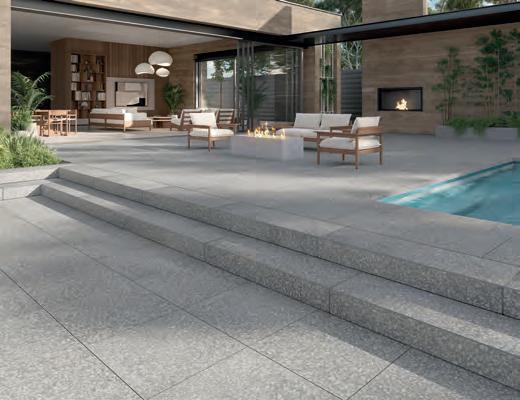
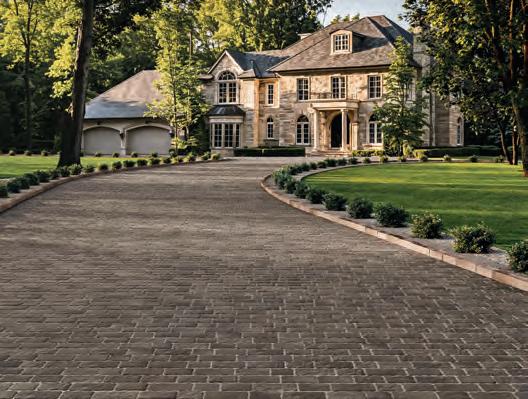
Techo-Bloc Oxford
Techo-Bloc’s Oxford paver combines classic colonial style with modern performance. Its factory-sealed Klean-Bloc technoloy defends against oil and organic stains, while advanced permeability helps manage stormwater and reduce flooding. Available in four distinctive colors, Oxford ensures timeless curb appeal for driveways that contractors can effortlessly install, providing success every time. techobloc.co/3QSHvgW

November
Belgard’s November porcelain pavers offer a combination of a refined, minimalist look paired with exceptional durability. November comes in an efficient 24” by 24” size for cost savings and faster installation time. Designed for outdoor use, these pavers are scratch-resistant, UV-stabilized, non-slip, and easy to maintain. Inspired by nature, this universal product enriches the look of any outdoor space with its organic beauty and aesthetics. belgard.com/products/porcelain-pavers/november-porcelain
Reminiscent of early American streets and walkways, Belgard’s Charlestone paver features the distinctive look of weathered, hand-cobbled stone. Sized in three-inch increments, it streamlines ordering, design and installation. The modular format makes it compatible with other Belgard pavers, including Origins and Dimensions, allowing flexibility to create unique designs for your clients that will last a lifetime. belgard.com/products/pavers/charlestone-paver


Granite Cobbles and Pavers
Quarried from natural stone and renowned for their low maintenance and durability, these are a premium choice for outdoor spaces. Available in a variety of colors and finishes, they can be customized to complement architectural designs. They offer a sustainable, cost-effective investment for both residential and commercial landscapes or hardscape projects.


The technology vying for the chance to save landscapers time and money
Historically, bidding for a job has been a laborious and time-consuming process for landscape designers. Not only did the designer need to establish a good relationship with the client, but they needed to take measurements, draw plans, estimate materials and labor costs, and do it all before losing the job to their competition.
Today, however, advances in tech seek to streamline the bidding process, so that landscape designers and contractors can spend more time on the work they actually want to be doing.
The market is full of apps, software, and various platforms promising to make landscapers lives easier—it can be difficult to know where to start.
Perhaps the most well-known option is PRO Landscape +. Founded in 1994, there are four main components to PRO Landscape +’s software: photo imaging, traditional 2D rendering, 3D rendering, and proposals. It runs on desktop or laptop, while the mobile Companion app—available on iPad and Android tablets—offers a light version with access to the shared plant library. Users can take a photo of the customer’s backyard and overlay design elements, plants, and hardscape to help see the designer’s vision.
“You can attach your pricing to the different plants, mulch and other landscape items from the large library of material, and then it’ll automatically generate a bid for you.


Once you’ve done the drawing, it will also generate a materials list, plant detail information, a quote and more. You have photo imaging, CAD, 3D rendering, estimating, all four in the same piece of software,” says David Sloan, sales manager at PRO Landscape +.
According to Sloan, most of his customers are not architects. The goal of PRO Landscape + is to give contractors, garden centers, independent designers, and other industry professionals who may not have training in CAD the tools they need in an easy-to-use format.
For the last 30 years, PRO Landscape + has continued to evolve the product as technology advances, and is exploring the possibility of rolling out an artificial intelligence-based upgrade to its offering in the near future.

It seems an inescapable topic lately. AI is everywhere from our social media feeds to self-driving cars. But what can AI do for our industry? Get a bid out faster, says Haley Hineman, chief of staff at Bobyard.
“Bobyard is essentially a modern takeoff and estimation software for landscape professionals. The whole platform is powered by AI that can read and scan landscape construction drawings and extract measurements very quickly,” says Hineman.

When Bobyard sought to understand the industry’s pain points, the tedious and labor-intensive bid process came up again and again as a major concern. “We’re helping to automate a lot of that process and make it easier for landscapers,” she says.
Bobyard’s AI differs from competitors in that it is being trained specifically for the landscape industry, notes Hineman.
“We’re one of the only companies that’s training our AI models from scratch, and specifically for the landscape construction industry. Our product is not a ChatGPT wrapper—where it’s a language learning model and we’re feeding it information and then it’s coming up with an answer. We’re using computer vision to train these models on thousands of landscape construction drawings.
“It is truly AI research,” says Hineman. “We’ve got an excellent team in San Francisco that are running GPUs and training the models on landscaping drawings, which I don’t think anyone else is doing. It’s very difficult.”
Bobyard continues to innovate as well, with upgrades focusing on irrigation and maintenance coming soon.
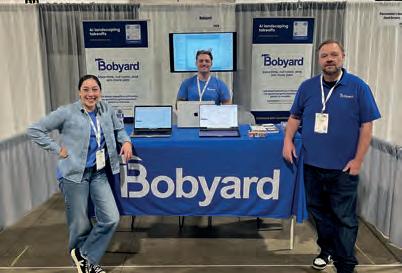
Buildxact, a cloud-based estimating and job management software, has built its customer base on the residential builder, but its product can be beneficial for landscape professionals as well.
Founded in 2011 in Australia, the software aims to give the small and medium business owners the same advantages as their larger competitors.
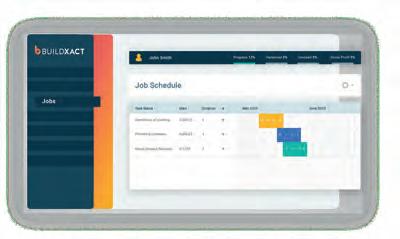
“We noticed that there was just this huge gap in the pre-construction side of the trades, and we were looking at how we can help these small to medium builders go into a job with certainty around the fact that they’ve estimated a project correctly and they’re not going to be losing money,” says Marissa Wagner, chief marketing officer at Buildxact.
Currently the software helps with various aspects of the construction process, including takeoffs, estimating, quoting, project management, and cost tracking. But Wagner shares that a second evolution called Buildxact 2.0—which utilizes AI trained on their proprietary database of projects—is launching in the next few months.

“We’re looking at this new wave of artificial intelligence and how we can go beyond generative AI to really help with those critical steps in the estimating cycle and in the project management cycle,” adds Wagner. “Once again, it all comes back to our core belief that builders in the small to medium segment have been neglected for so long when it came to giving them the technology and tools that helps them compete at higher level with these larger builders. Buildxact gives them ability to get discounts from their suppliers, to be competitive in their bids, to really make sure that they’re serving their customers as best as they can.”
Landscapers now have access to technology that even just two decades ago would have seemed like a far-off dream. From advancements in estimation and imaging to project management, it is clear AI will have a dynamic impact on the landscaping industry.
As more members of the industry begin to adopt AI-driven software, and as the technology continues to develop and improve, we can’t help but look towards the future and the creativity that will be enabled by this time-saving tech.

Nataly Mualem shares tips for navigating the H-2B Visa
If you’ve been in landscaping for more than a season, you probably already know: finding reliable labor in peak season can be brutal. Clients want pristine lawns, perfectly edged beds, and hardscape installs yesterday—but getting a crew to show up, much less stay for the season, is a challenge many companies face year after year.
That’s why more and more landscaping businesses turn to the H-2B visa program. It’s a seasonal work visa that allows U.S. employers to hire noncitizens for temporary, non-agricultural work when there just aren’t enough local workers to meet the demand. And for this industry, it’s become nothing short of essential.
seasonal labor crunch
schedule is packed with cleanups and prep. Then, winter slows everything down—or if you’re in snow and ice, it ramps up.
This seasonality is what makes the H-2B program a fit for so many landscapers. You don’t need workers year-round—you have a very seasonal demand. But that temporary need comes with its own set of problems.
“YOU DON’T NEED WORKERS YEARROUND—YOU HAVE A VERY SEASONAL DEMAND. BUT THAT TEMPORARY NEED COMES WITH ITS OWN SET OF PROBLEMS”
Local workers often aren’t interested in short-term, physically demanding jobs, especially when there’s no guarantee of work past the season. Even when companies offer good pay and benefits, hiring and keeping a consistent local crew is a constant struggle. And when you’re turning down jobs because you don’t have the staff to do them, it cuts right into the heart of the business.
businesses to petition for foreign workers to fill temporary positions. It’s not about cheap labor (employers must pay a prevailing wage set by the government); it’s about meeting demand when the domestic labor pool isn’t enough.
But here’s the catch: the program is capped. Each year, only 66,000 H-2B visas are available—33,000 for jobs starting October to March, and 33,000 for April to September. That number doesn’t come close to matching demand.
In recent years, the Department of Labor has received over 96,000 worker requests for just one half of the year. That means even perfect, on-time applications might not be selected, simply because they lost in the lottery.
For landscapers trying to plan their season and lock in crews, that uncertainty can be devastating.
Making H-2B work: Strategies that actually help
The green industry doesn’t run on a steady, year-round pace. It’s feast or famine. Spring hits, and the phone starts ringing off the hook. Summer rolls in, and the days get longer, hotter, and busier. By fall, the
The reality of the H-2B program
Enter H-2B visas—what many call a “lifeline” for seasonal industries like landscaping. The program allows
Despite the challenges, the H-2B process doesn’t have to feel like a game of chance. There are smart strategies businesses can use to improve their odds and better align the program with their workforce needs.
1. The October visa strategy
Filing for an October 1 start date places you in the less competitive first half of the fiscal year. Last fall, around 80% of all cases were in Group A—the earliest priority group. Submitting right when the window opens gives you better odds. Even better?
qualify for multiple petitions. Submitting separate applications for different job titles or work sites can increase your chances— just be sure each petition is distinct.
“IF YOU OPERATE IN MORE THAN ONE REGION OR OFFER A VARIETY OF SERVICES, YOU MIGHT QUALIFY FOR MULTIPLE PETITIONS”
Workers hired in October are capexempt for jobs starting any time before the following September 30. That means you can reassign those same workers later in the year without using another visa slot.
2. Segmenting your season
Some businesses improve their odds by filing separate applications for different job titles or work sites. If you’ve got a branch in another state, or if your team does both lawn maintenance and hardscaping, you might qualify for distinct petitions. Just be careful—applications that appear to duplicate each other can get flagged or denied. Work closely with your legal team to make sure duties and locations are clearly separated. When done right, this approach gives you multiple entries in the lottery.
3. Diversifying job titles or locations
If you operate in more than one region or offer a variety of services, you might
Work with your attorney to clearly separate job duties and geographic areas.
Everyone rushes for April 1, but starting a few weeks earlier or later can reduce competition. If your seasonal needs allow, consider adjusting your timeline—especially when supplemental visas are in play.
5. Partner with other businesses
This one’s outside-the-box—but really smart. Think of it like a pro sports team trading players to cover roster gaps. Some companies partner with others in different industries or regions—say, a ski resort or seafood processor that only needs workers for the winter. Once their season ends, those workers can transfer (cap-exempt) to a landscaping company without needing a new visa spot. These alliances require some planning and paperwork, but they offer a workaround.
6. Three-year registration advantage
When you’re approved for H-2B, your business is registered with the Department
of Labor for up to three years. That registration doesn’t guarantee visas each year, but it simplifies future applications by reducing the documentation burden. If you know you’ll be relying on H-2B year after year, this can save time and hassle.
The H-2B visa program isn’t perfect. It’s complex, competitive, and often frustrating. But for many in the landscaping world, it’s the only way to meet the seasonal labor needs.
There’s no one-size-fits-all answer. But with planning, thoughtful segmentation, and smart partnerships, more businesses are finding ways to make it work.
If the system feels hard to navigate, that’s because it is. But every year, more companies succeed—by learning the rules, playing the long game, and staying just a little more strategic than the competition.

Nataly Mualem is the founder and managing attorney of Mualem Firm, a boutique, full-service immigration law firm specializing in the H-2B visa program. With extensive experience navigating the complexities of seasonal and temporary labor solutions, she has successfully guided hundreds of businesses through the process. mualemfirm.com
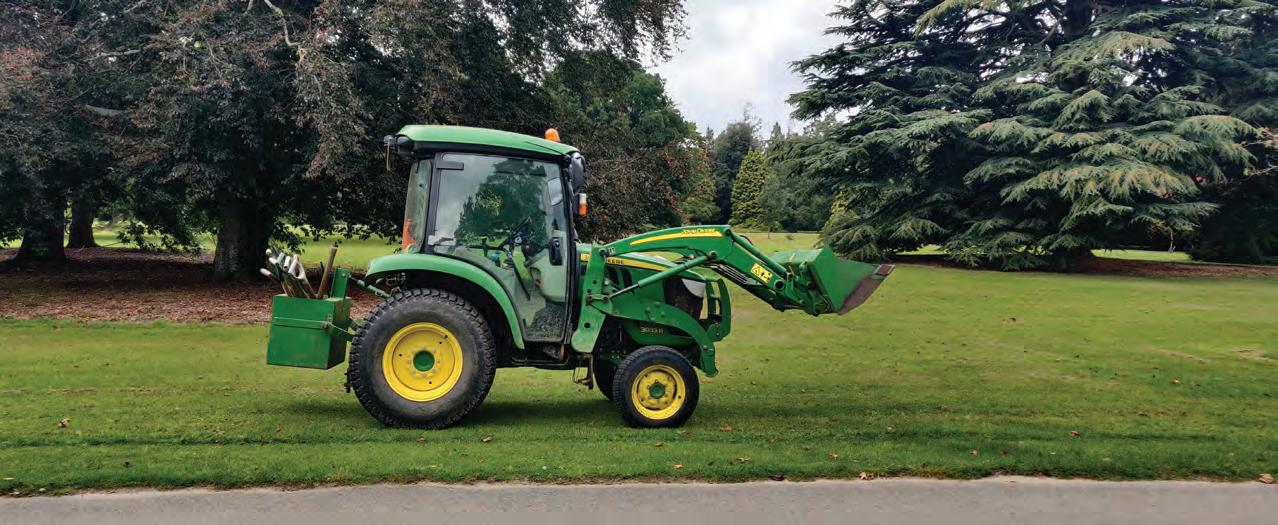
























































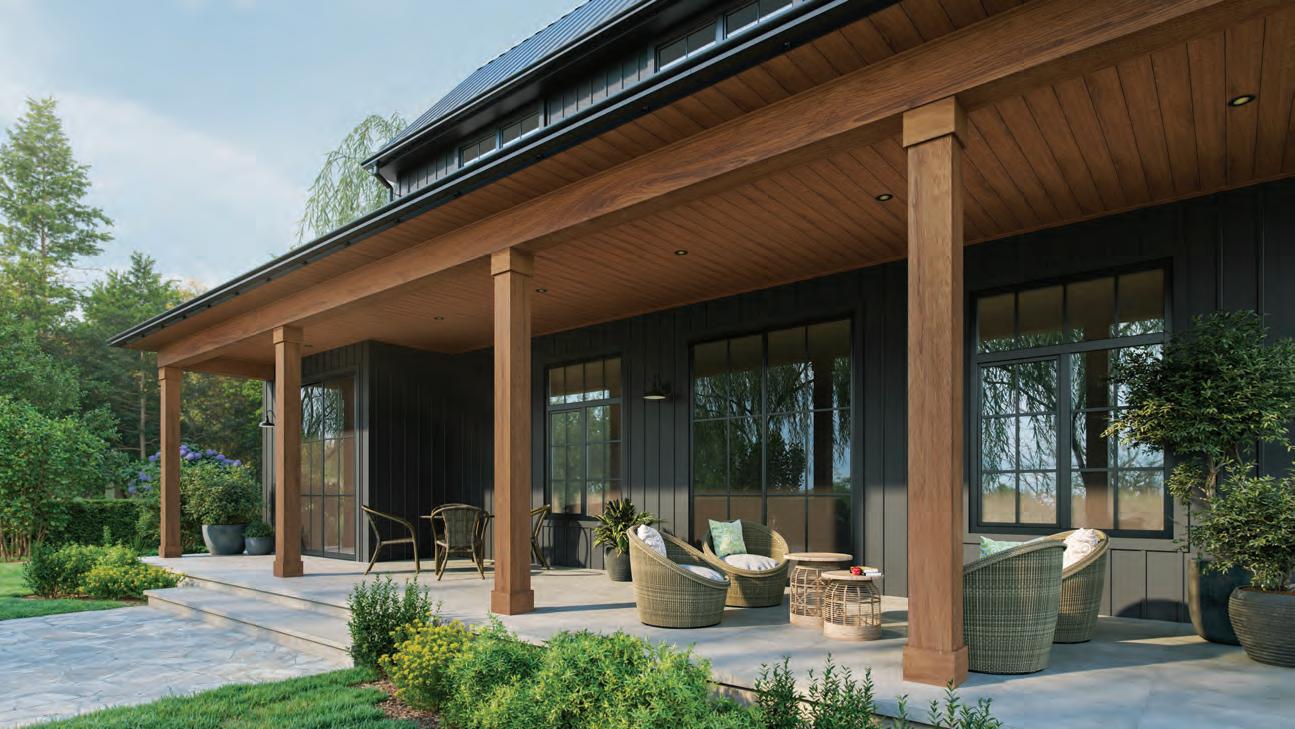
Homeowners increasingly want outdoor spaces that reflect the interior in both aesthetics and functionality. Here are nine ways to do just that.
As outdoor living spaces continue to be in demand, homeowners’ tastes and preferences are rapidly evolving to elevate functionality and style. Among the shifts is a growing trend toward outdoor areas that reflect the indoor environment—in appearance, in purpose, and in style.
Just like the rest of the house, outdoor spaces are increasingly personal. No matter the size or budget, homeowners are choosing designs and products that reflect their lifestyles and function for their needs. Here’s how designers and builders can elevate outdoor spaces to match the comfort and convenience of indoor living.
Seamless connections from indoors to out have been a trend for some time, helping to expand the interior footprint both physically and visually while increasing connections to nature. Much
of this is thanks to the decade-long rise in availability of multi-panel patio doors that slide or accordion out of the way to create expansive openings. Recently, coordinating indoor flooring with exterior decking has made such designs even smoother.
Beyond traditional outdoor rooms such as screened-in porches and solariums, creating designated spaces through visual or physical means can make an outdoor area feel more like the interior while giving clear delineation between activities.
similar purpose while also infusing a more indoorsy feel. For a more definitive separation in larger spaces, try planters or linear fireplaces, pergolas, or multi-level decks in combination with patios, private garden spaces, and outbuildings.
Even the household staple curtains can come into play. Added to a pergola, they can bring privacy, define an entertainment space, and add a cozy indoor element.
“SEAMLESS CONNECTIONS FROM INDOORS TO OUT HAVE BEEN A TREND FOR SOME TIME”
Areas for dining, sitting, or relaxing may reveal themselves via the deck itself by using different plank colors and patterns, such as picture framing or inlays. Outdoorfriendly area rugs and décor provide a
Furniture is having its own refresh moment, with stylish pieces replacing the flimsy chairs of old. A growing selection of weather-resistant, high-end options lets homeowners enjoy the look without worrying about durability. For entertaining, comfort is key—along with varied seating arranged for easy conversation.
Much like an interior living room, consider anchoring the outdoor space with a beautiful focal point, such as a firepit or stone fireplace, which adds ambiance as well as an inviting and organic texture to the environment. The coordinated use of materials such as stone cladding, brick veneer, and stacked stone will help marry the interior and exterior areas seamlessly.
Stuck at home during the pandemic, homeowners sought to expand their outdoor space and extend its livability into colder months and darker evenings. A covered or shaded area to protect from rain and sun is critical. Outdoor heaters, a product that first gained popularity for restaurants moving seating outside, have become more readily available, sized, and styled for residential use.
Lighting is perhaps the most important, and we’ve long evolved past the simple spotlight. Lighting that integrates into decking and railing provides both safety and ambiance. To elevate the mood even further or add a bistro-like feel, mix in lanterns, battery-powered candles, or string lights. Smart sensors and programmers can allow users to adjust
lighting schemes for areas of the deck, as well as provide a security element.
Technology is allowing indoor comforts to migrate outside. Integrated waterproof sound systems that don’t sacrifice quality, smart lighting, and even televisions bring more opportunities to entertain and enjoy the outdoor space for longer periods.
Elements of wellness are in demand in a variety of ways as homeowners seek to escape the stress of current events and busy schedules. How this translates depends on the homeowner’s interests and budget, but it’s about infusing functional elements that provide a getaway or a soothing hobby. These might include serene garden spaces; yoga platforms in a quieter, secluded area; small plunge pools; water and fire features; and even dedicated cooking appliances such as a pizza oven.
Infusing bold elements can differentiate an outdoor space while breaking up monochromatic color schemes. For an interior-like accent wall, you might consider manufactured stone in a
contrasting color or even a colorful mural. For those not willing or able to commit to a larger statement, décor can do the trick just like inside: Think colorful throw pillows, wall décor, area rugs, or planters.
Having an outdoor cooking space goes way beyond a grill. A working outdoor kitchen can function much like its interior counterpart, with a small fridge, stovetop, sink, and storage. Include adequate countertop space for food prep and serving. Situate the outdoor cooking area so there’s seating nearby; that way, the cook can still take part in conversation.
Outdoor spaces are evolving to meet demand for functionality and personalization. Like interiors, thoughtful design and product choices elevate even small spaces into something unique.
Previous page: Grove Collection column wraps and beadboard add warmth to this covered area.
Current page: This linear fire feature is clad in Cultured Stone’s Winterhaven Pro-Fit Alpine Ledgestone for the Regency Creekside Meadows Clubhouse in Bath, PA. ©Taylor Photo.

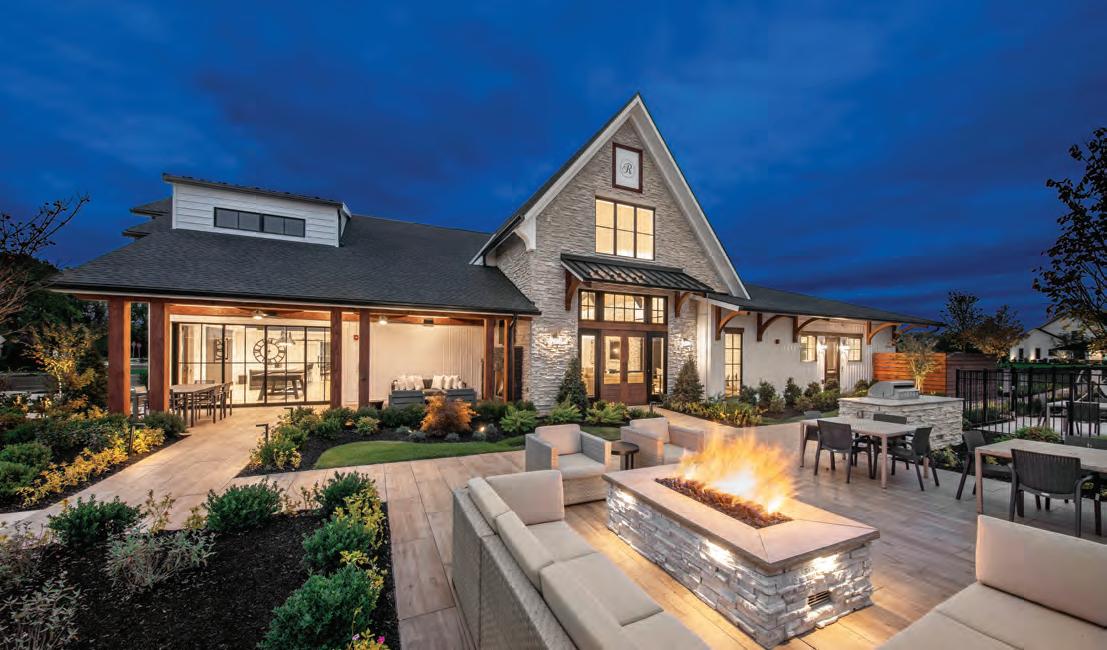
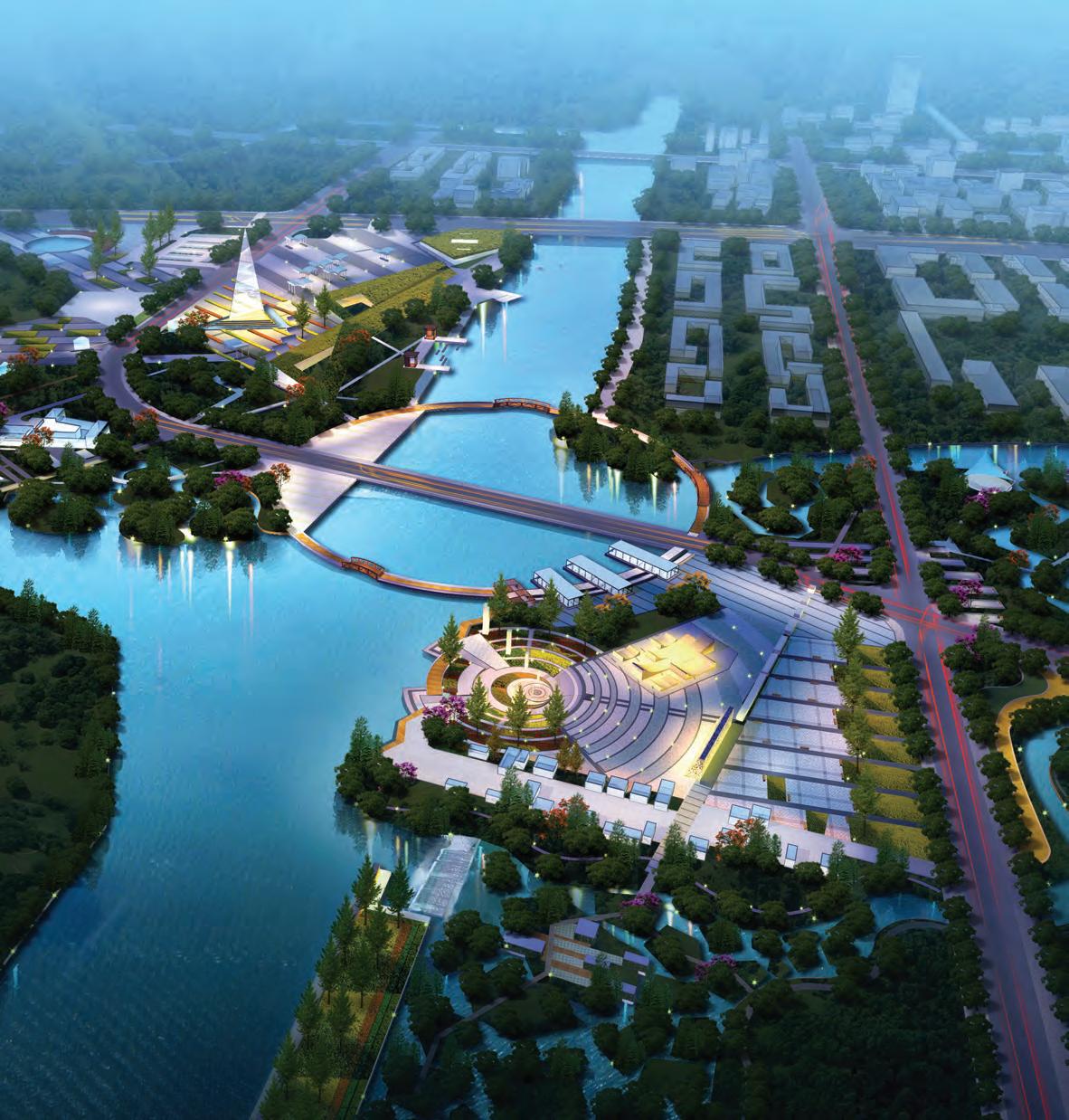
Pro Landscaper USA asks quick-fire questions to gain a small insight into the people who make up our industry. To take part, email celia.cummiskey@eljays44.com
Logan McEniry
Oceanside, CA Ace Hardware acehardware.com

Mountains or ocean? Mountains.
Other than the US, which country’s landscape inspires you the most?
I think the English style is beautiful with all the plants.
One thing that you think would make the industry better?
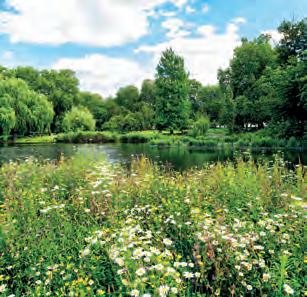
I think the industry could be more united. I often times see, in small industrial businesses, everyone competing against each other.
Who would play you in a movie? Definitely Brad Pitt!
What would you blow your budget on?
I would love to own tons of “toys” like motorcycles, ATVS, everything like that!
Karaoke song?
Tequila, not a singer and I can remember that word.
Best piece of advice?
Sometimes you just have to put your head down and work.
Dream project?
Renovating an entire house from the studs, inside and out.
Couldn’t get through the week without… White monster energy drinks

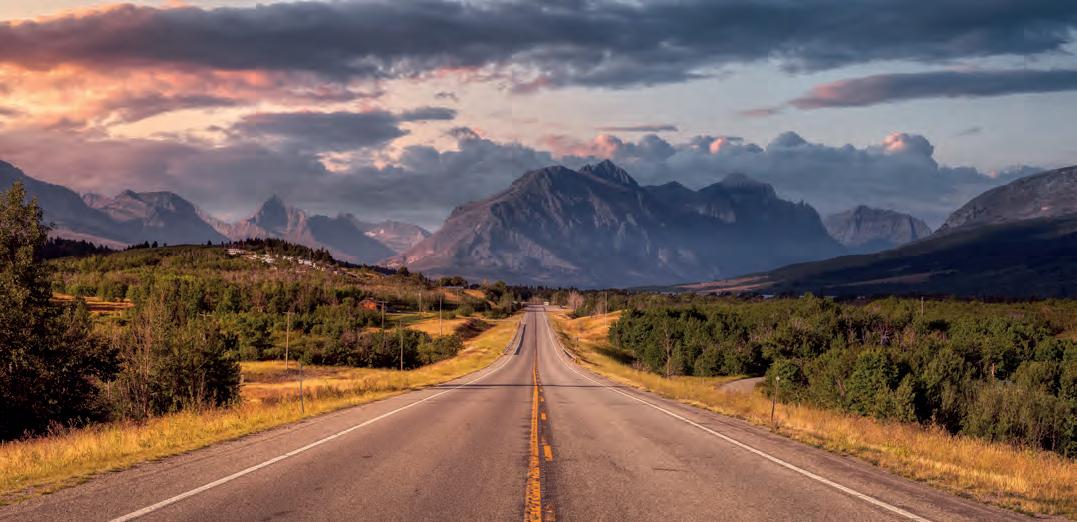
Rama Nayeri
Creations Landscape Designs creationslandscapedesigns.com

Mountains or ocean?
To live? Ocean. I would love to live by the water and have that view from my home. To hide for a while, mountains. I would love to have a cabin in the woods that I can retreat to for a few days when I want to just get away and hide.
Other than the US, which country’s landscape inspires you the most?
In 2001, I spend three months in Italy on a study abroad program and saw lots of great gardens.
One thing that you think would make the industry better?
Greater understanding of cost by the client. People sometimes don’t get that things cost something, and you cannot get it for free.
Who would play you in a movie?
Meryl Streep, only because she is a shape shifter that
can morph into any character fabulously.
What would you blow your budget on?
Currently, I would spend on fixing my house or a new car.
Karaoke song?

Def Leppard “Mirror Mirror” or Led Zeppelin “Trampled Under Foot.”
Best piece of advice?
My dad used to say that if you are supposed to be somewhere at a certain time and you show up late, then you have disrespected the person who invited you.
Dream project?
My own (future) garden, in which I have land to do with as I wish.
Couldn’t get through the week without…

Tea! Irish or English breakfast during the day and green at night.



